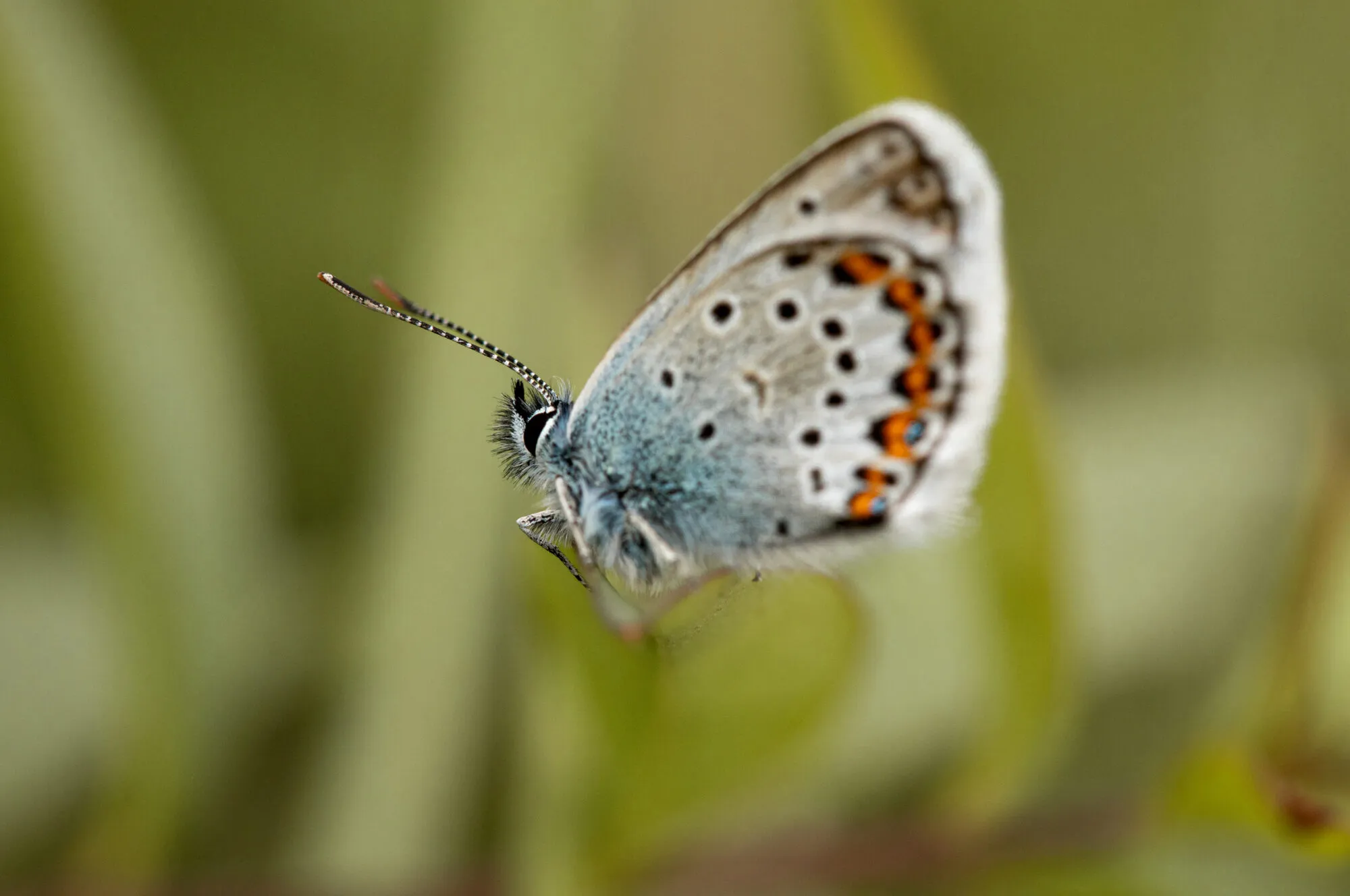
Perranporth: in the wild




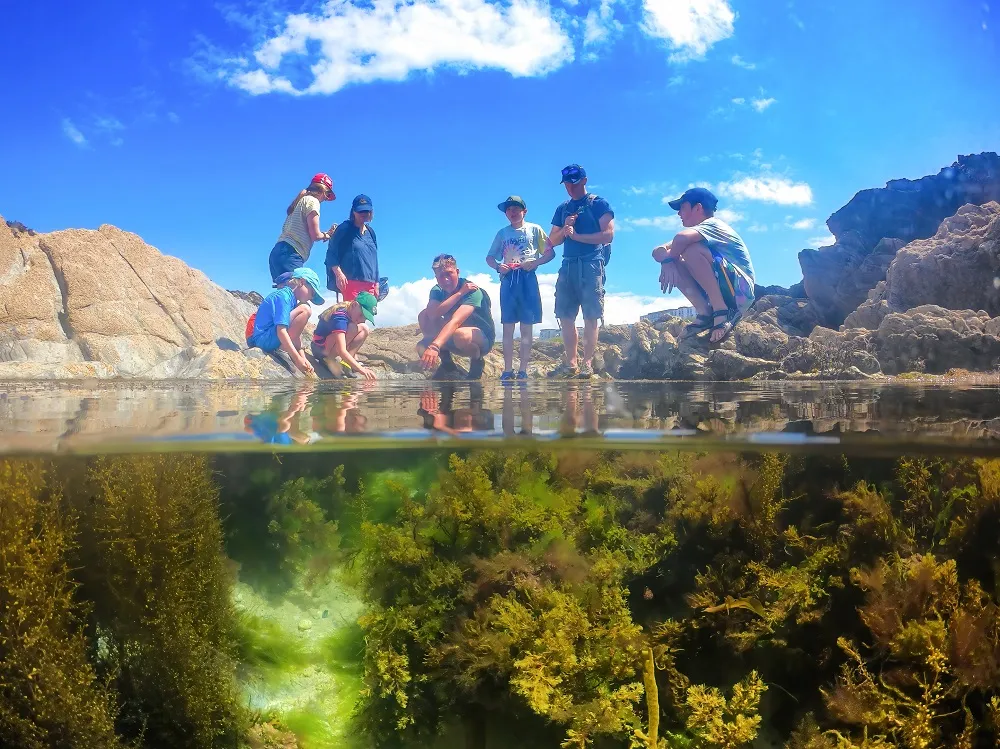
“The minibus is buzzing with conversation as we drive the family group back to their hotel. As the youngest son gets out, he hugs the guide and says, ‘I want to be a marine biologist just like you.’”
We recently caught up with our friends from Newquay Wild Activities, who gave us a run down on their latest Rockpool Ramble on Fistral beach.
Visiting with a large group? Discover our large holiday homes perfect for big families or friend groups.

Image credit: David Kirwan
The day started when Liz picked them up three hours earlier from Watergate Bay. A lovely group down on holiday and booked with Newquay Wild Activities to experience a rockpool ramble. The van pick up means they can leave their cars in the car park and not worry about navigating the busy Newquay streets. They arrive at Esplanade Green overlooking the world famous South Fistral Beach.
Want to stay in Fistral? Have a look at our luxury holiday cottages in Fistral.
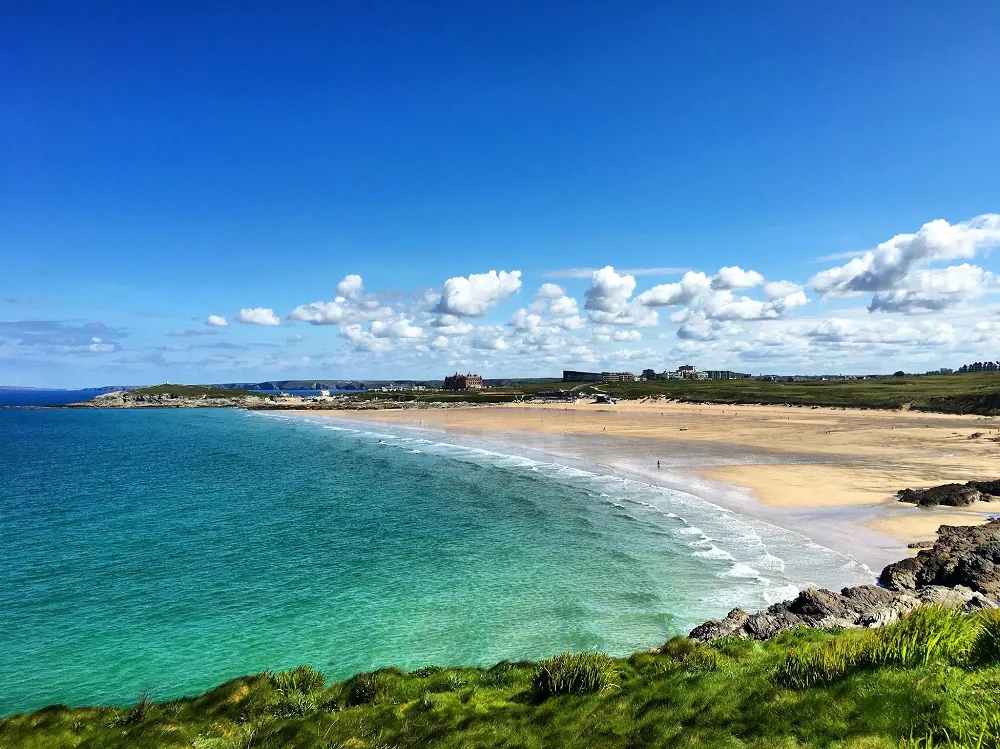
Image credit: Neil Wilkinson
Here they meet their guides, two passionate locals who are as excited as the group to share and explore the rocky shore.
There are some amazing pools on South Fistral that contain a wondrous number of species – each with their own story to tell. Even the seaweed has some secrets to share, if you look close enough. A multitude of shells cling to them for security such as the iridescent blue ray limpet as does the beautiful Stalk Jellyfish.
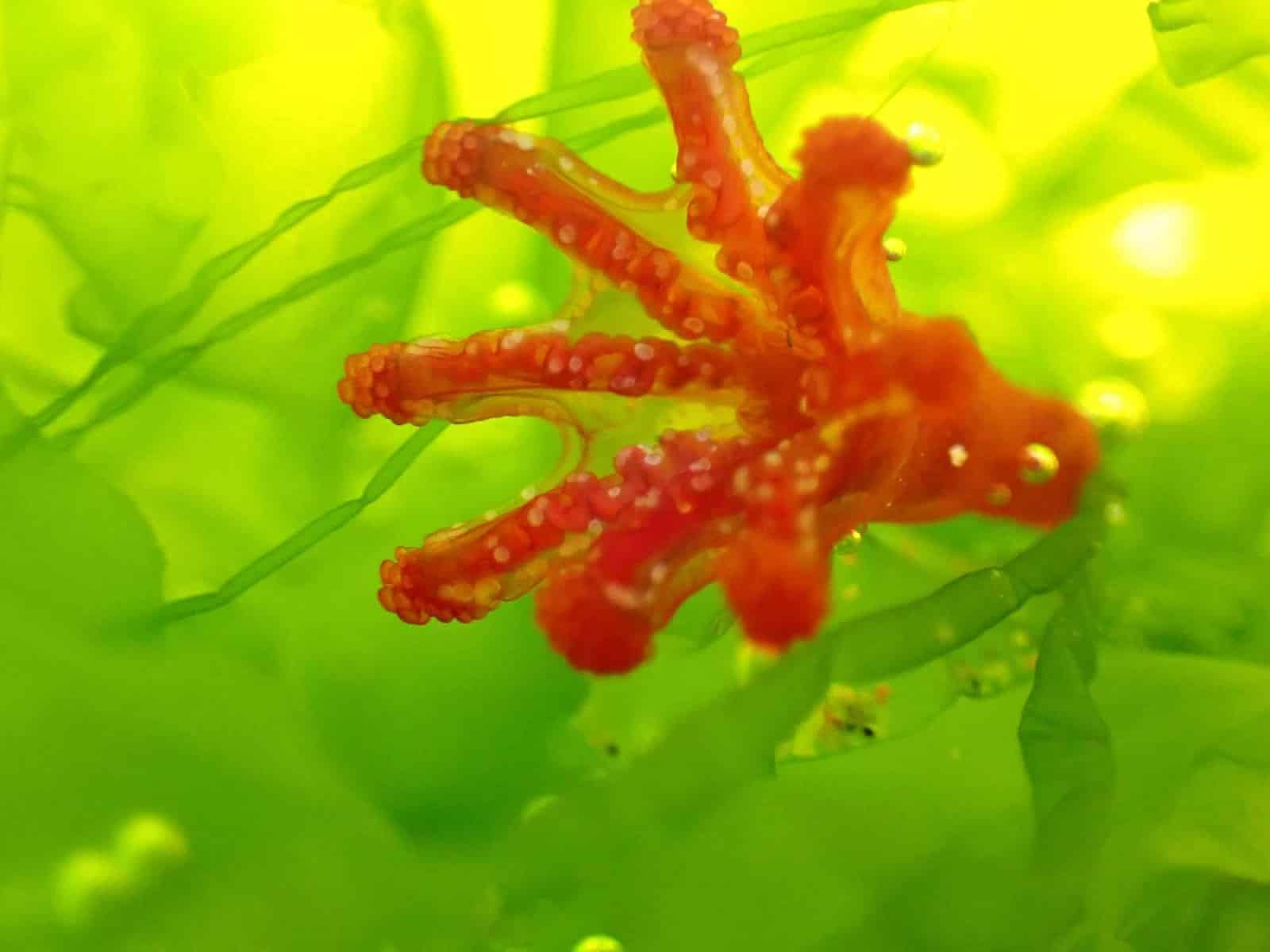
Stalk Jellyfish by Ivan Underwood
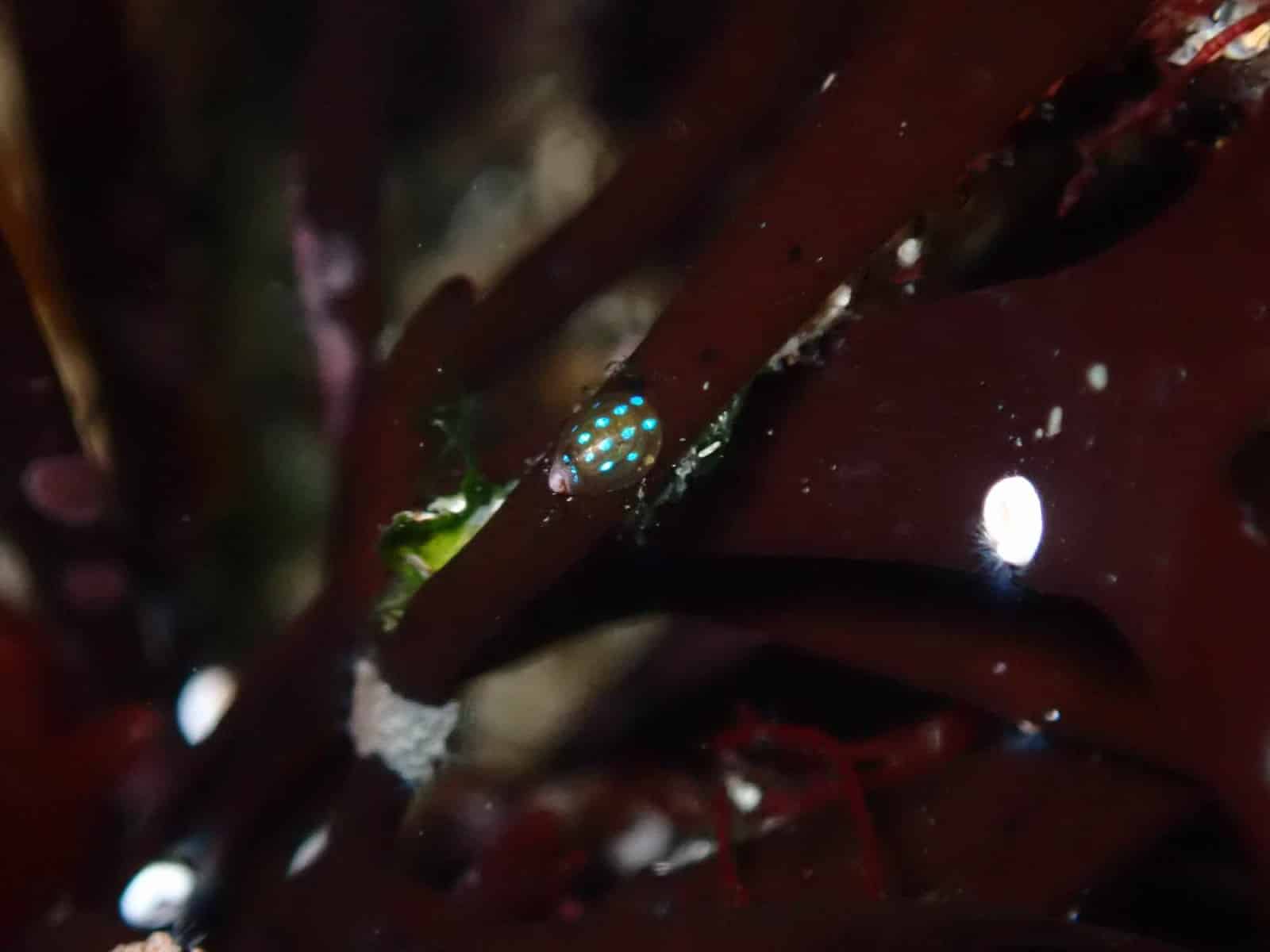
Blue Rayed Limpet by Zeni Hayton
The group wander their way down towards the surf to look at the deeper pools and rocks covered in thousands of mussels and barnacles, always keeping an eye out for wildlife passing by in the bay. Crabs are discovered, fish swim by and shrimps come and play on their toes. Starfish of all types are found – they are incredible creatures that eat algae while clambering over rocks. Did you know they can lose a limb for an easy getaway if they are ever in danger?
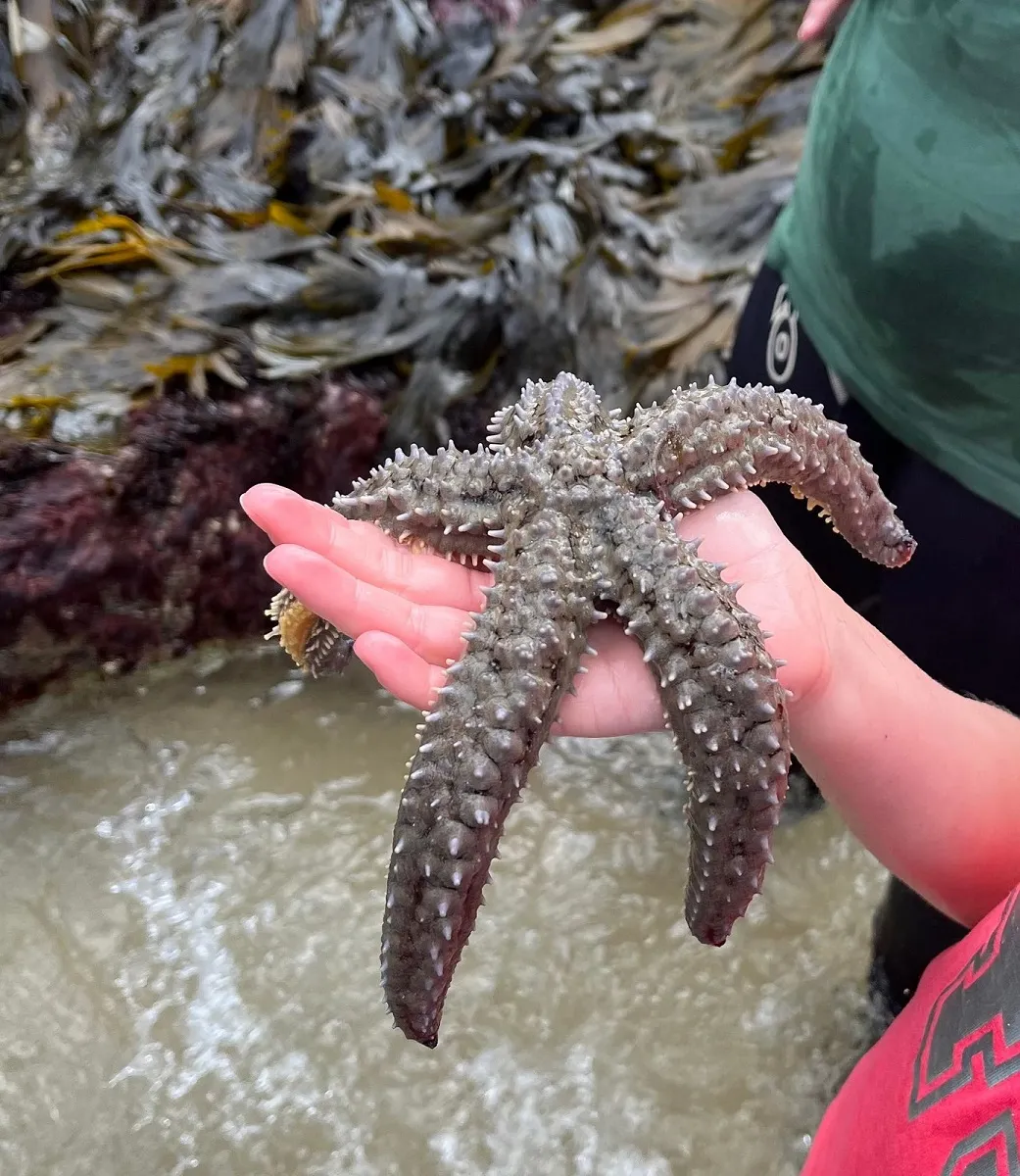
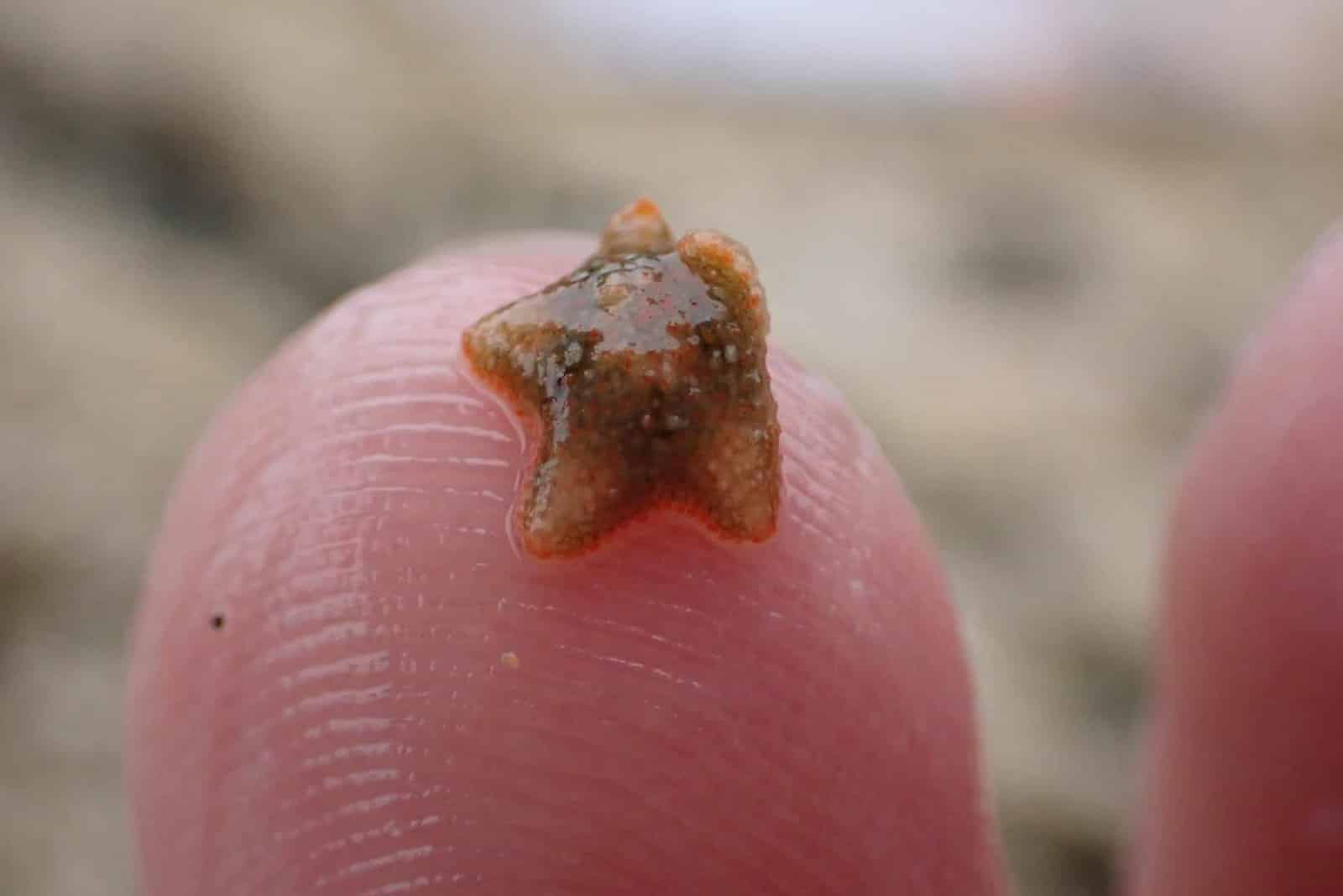
Spiny Starfish and Cushion Star by Gwynnie Griffiths
As the tide exposes more rock, anemones begin to close to protect themselves while they wait for the protection of the water.
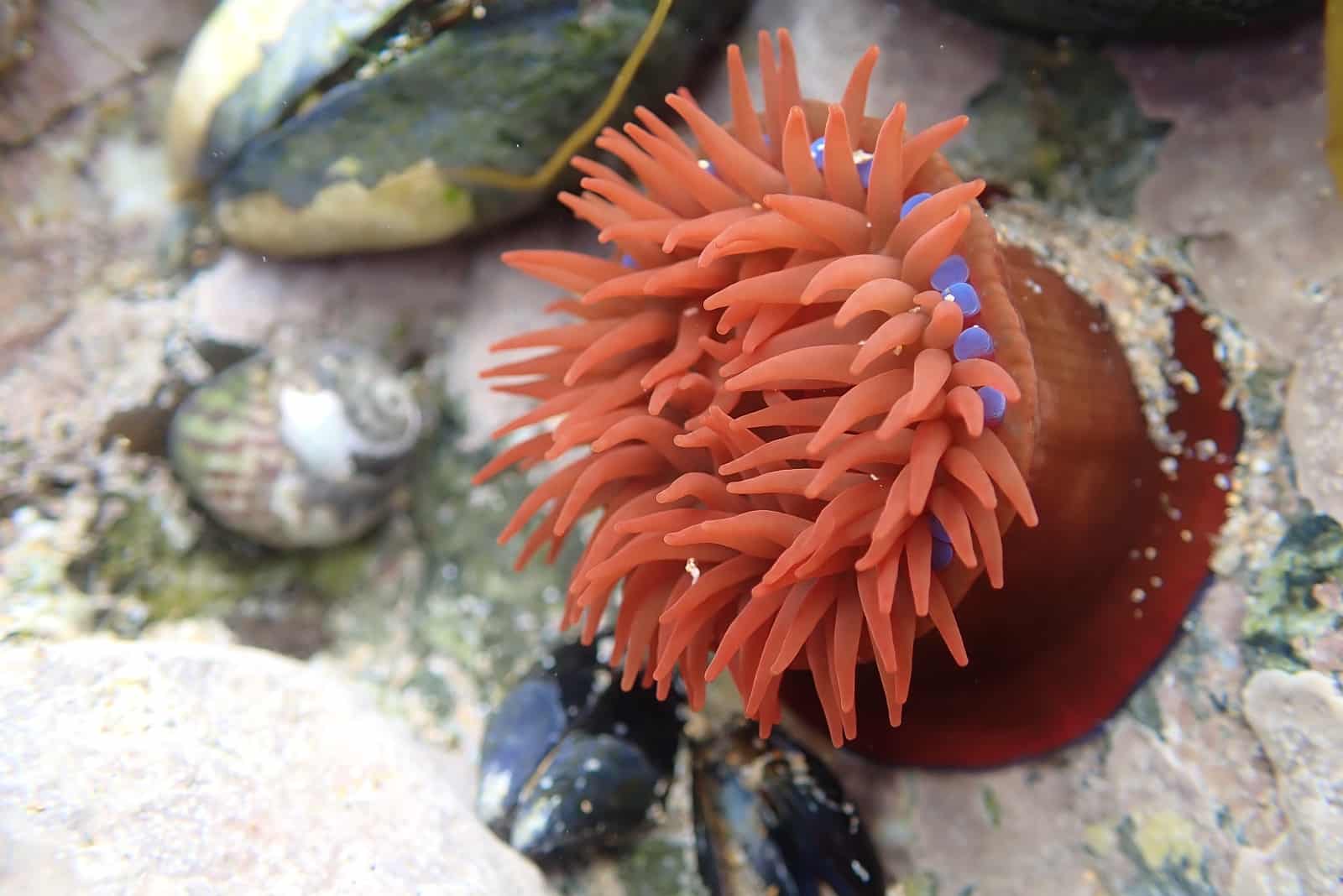
Anemone by Josh Symes
The group are enthusiastically hunting for more animals as Liz returns with their pasty and drink. A perfect spot to enjoy some sustenance before the slow meander back to the steps.
Amazingly, as they clamber their way off their beach, more wildlife is spotted – a Stone Chat just hanging out on the brambles!
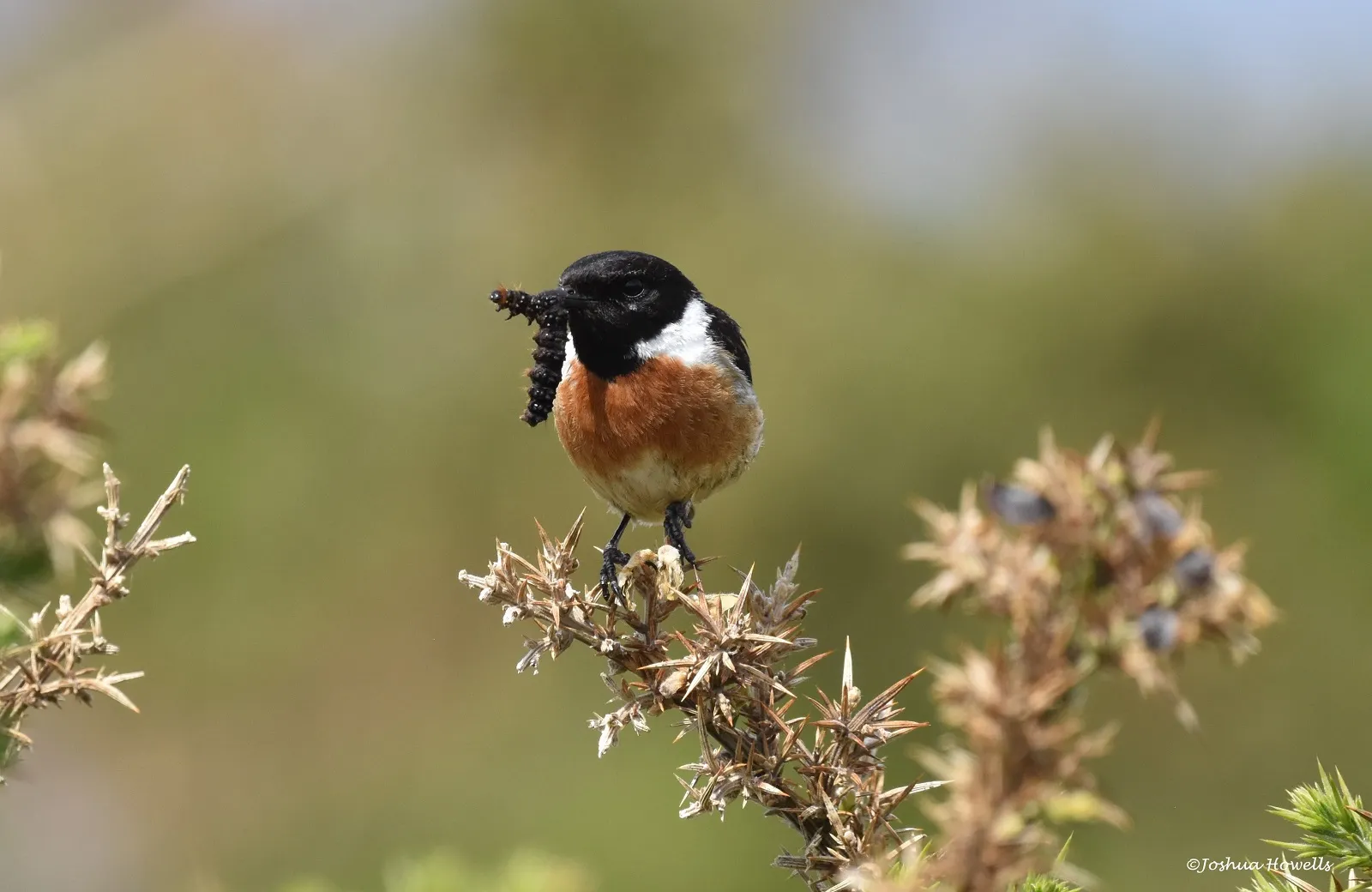
Stone Chat by Josh Howells
There is so much to explore on Newquay’s shores. Liz and the group spend the drive back talking about everything they saw. The guides log all the wildlife information ready to send to the record centre which the group helped to collect (they are now citizen scientists!) and the guides get ready for their next group – this time… a Wildlife Walk around the headlands of Newquay to spot some of the bigger, more elusive wildlife.
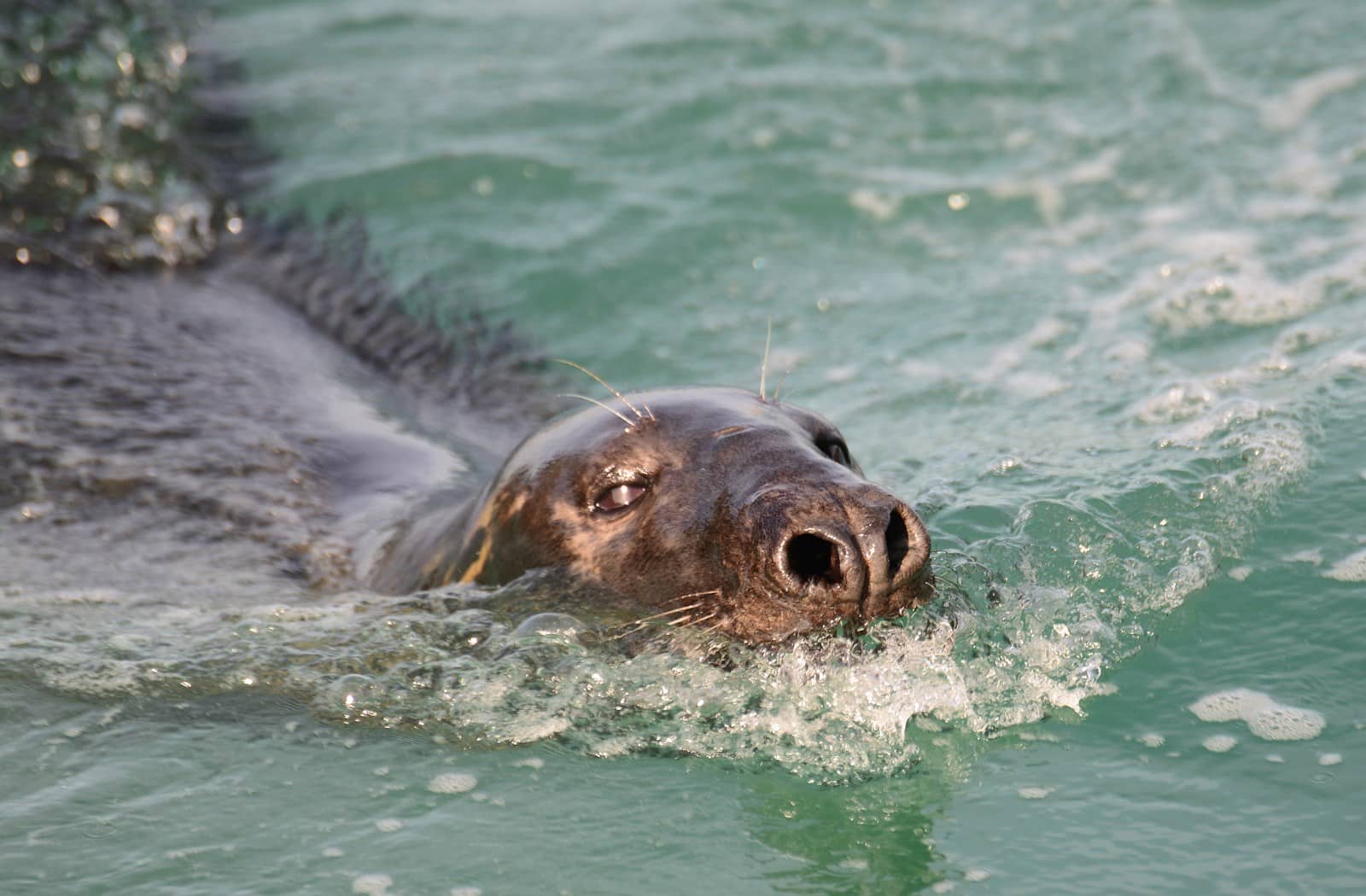
Grey Seal by Adrian Langdon
Newquay Wild Activities is a brand-new Social Enterprise set up by Liz and Laura in 2022 – it stemmed from a decade in the marine conservation sector in Cornwall, a fabulous network of friends and colleagues and a yearning to show tourists and locals that Newquay has so much to offer.
Discover what lies beneath our rockpools and the wildlife that shares our shores. Book onto a Rockpool Ramble or a Wildlife Walk with mini-bus pickup included. Learn how to collect valuable scientific data that can help to inform conservation research and national policy. Explore the north Cornwall coastline with experts on hand to guide you.
For more information visit Newquay Wild Activities for the summer dates and activities. Including the spectacular night-time rambles – see what happens in the cover of darkness!
Dive into the exciting world of alternative surf activities in Cornwall and discover new ways to enjoy the waves
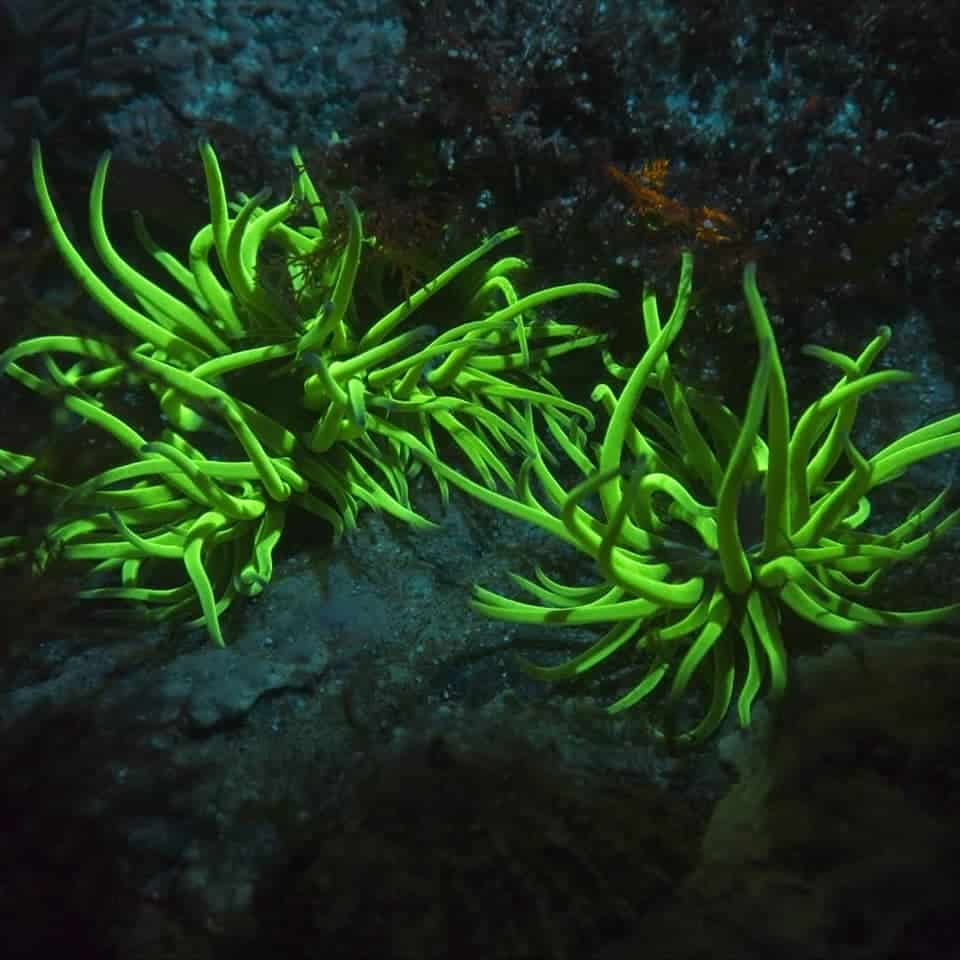 Anemone by night, Josh Symes
Anemone by night, Josh Symes
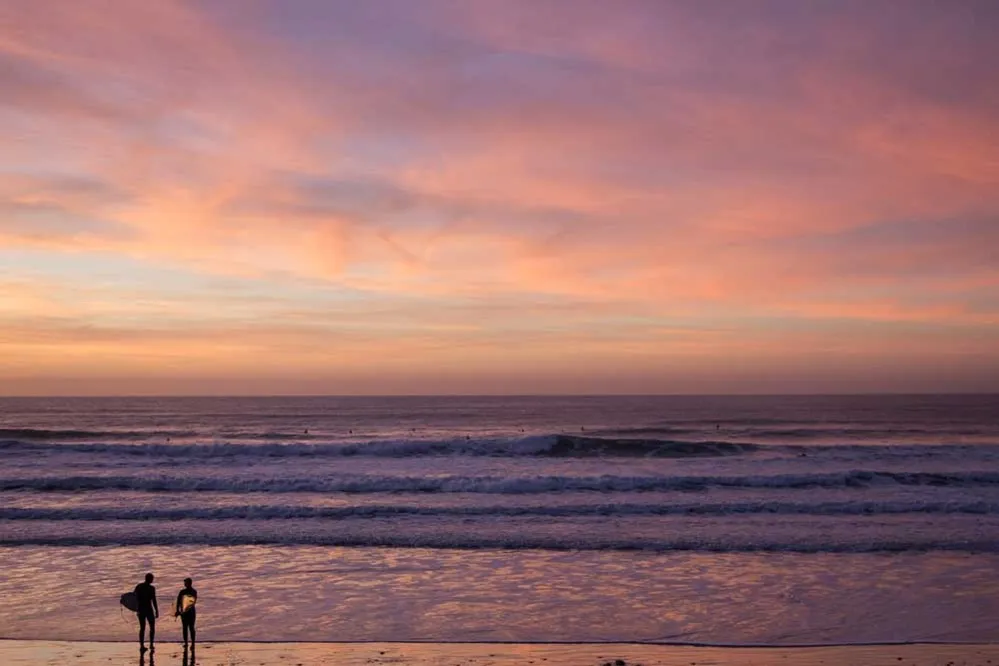
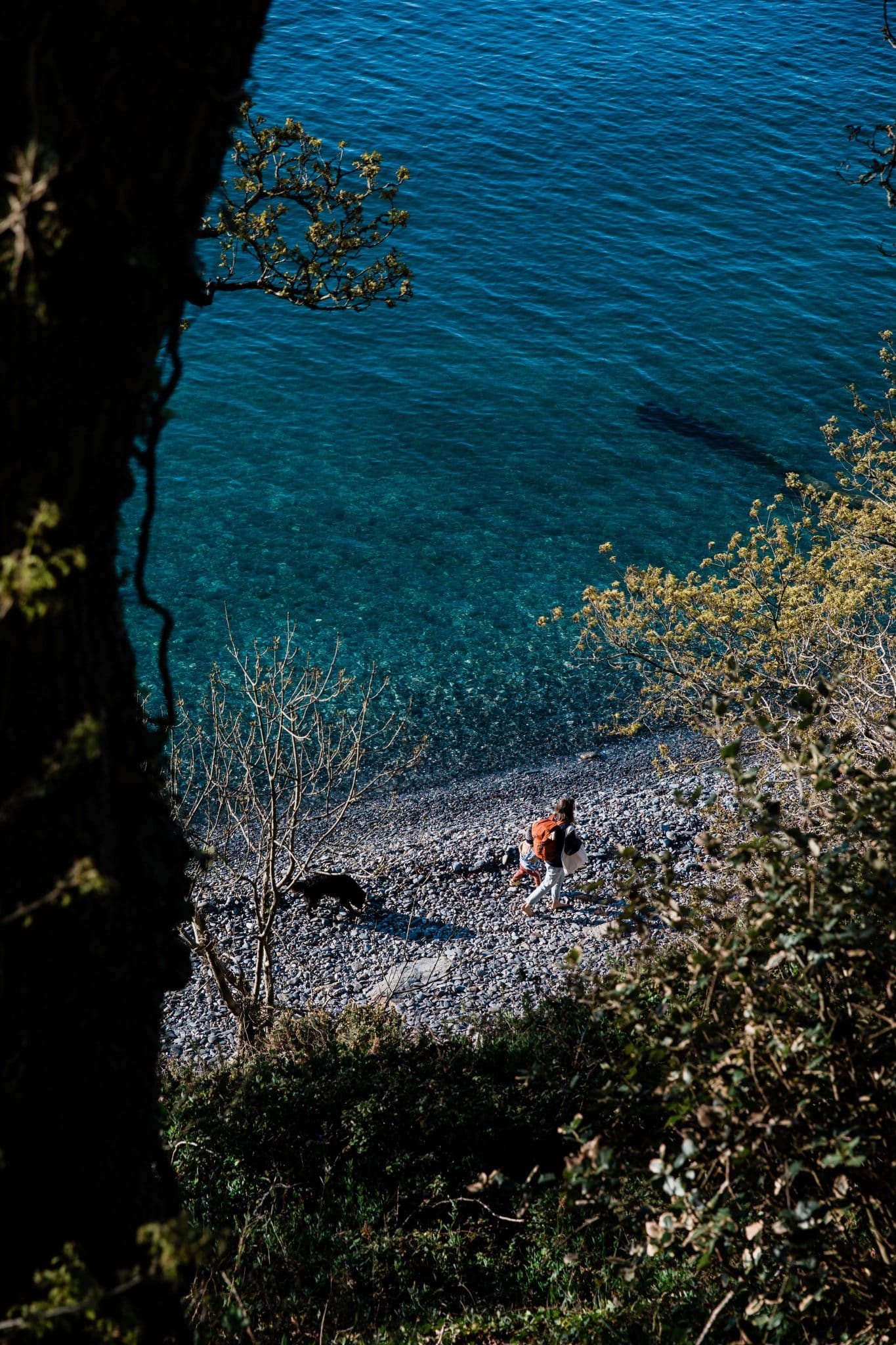
 Seeking samphire beside the estuary and seaweed in rocky pools. Julia Bird of seaweed pressers Molesworth & Bird and Caroline Davey of Fat Hen reveal stories of coastal discovery…
Seeking samphire beside the estuary and seaweed in rocky pools. Julia Bird of seaweed pressers Molesworth & Bird and Caroline Davey of Fat Hen reveal stories of coastal discovery…
Discover unbeatable savings and unforgettable experiences with Beach Retreats’ exclusive special offers.
The oldest fossilised seaweed, discovered in 2020, was found in one-billion-year-old rocks in northern China, making seaweed millions of years older than the distant ancestors of our land plants. Today there are over 650 different species of seaweed around Britain’s coasts which have for centuries been a source of fascination for artists.
Anna Atkins’ British Algae: Cyanotype Impressions, published as a serial between 1843 and 1853 is a collection of cyanotype prints of seaweed. This early form of photography using paper treated with a light-sensitive solution that turns blue on exposure to light is thought to be the first published book illustrated with photography.
For Julia Bird, a Victorian collection of pressed seaweeds discovered by her business partner Melanie Molesworth in an antique shop over 20 years ago was the beginning of her journey to start foraging for seaweed along the Cornish coast, aiming to capture its ephemeral beauty through pressing.
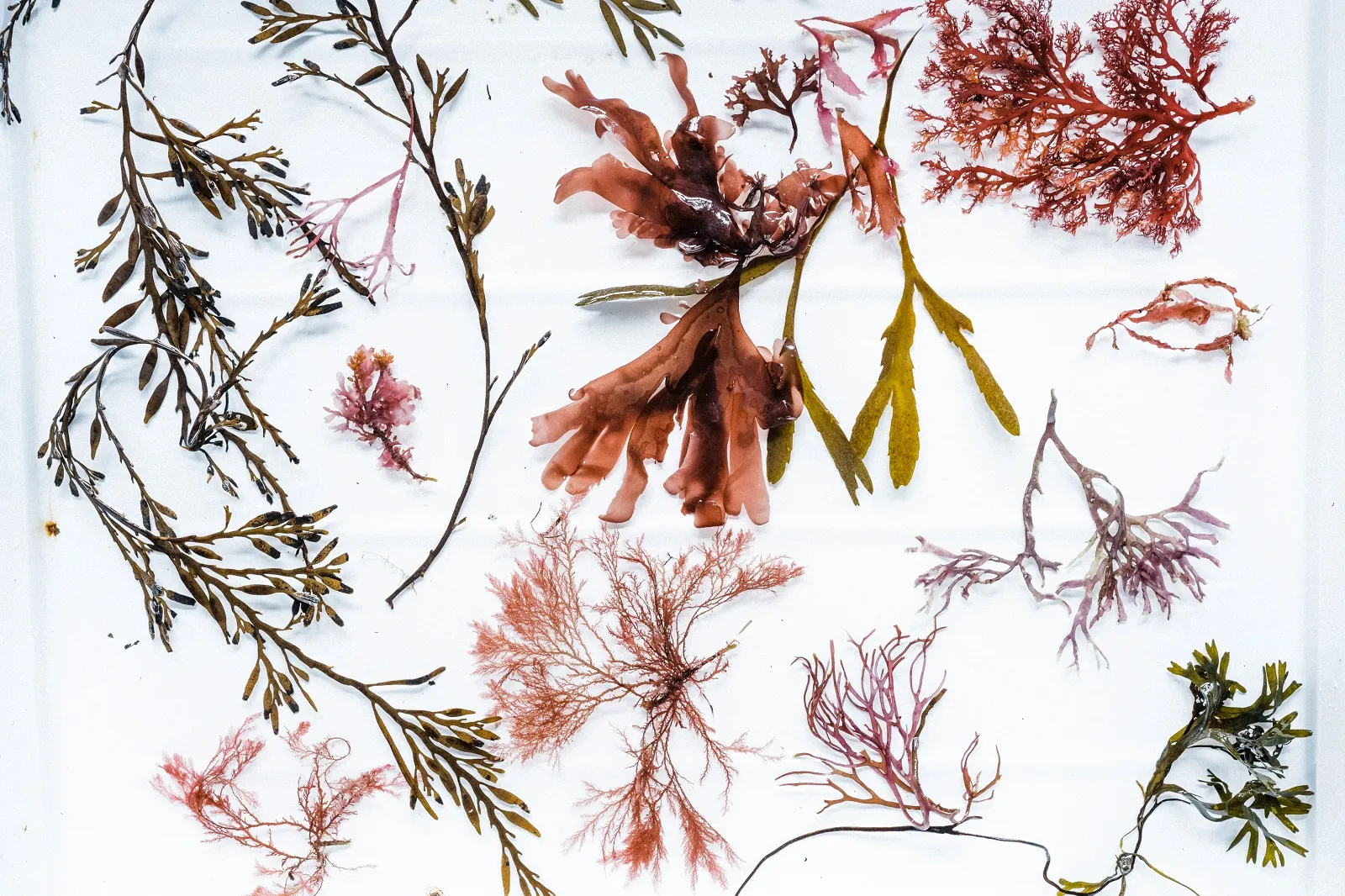
Image credit: Matt Austin
I’m a lifelong collector of nature really,” says Julia. “I’ve always collected whether it’s flowers or lichen or stones. And my whole life has been sort of sea orientated; I’ve always been a sea swimmer.”
After moving to Cornwall in the early 2000s, Julia started experimenting with pressing seaweed she had foraged when out swimming. “I started looking for seaweed and bringing it home and learning how to press, which of course back then there was nothing out there, you know, in those days. My first press was probably in 2004.”
After running a children’s shop in Fowey for 15 years, Melanie’s encouragement to start publishing her seaweed pressings finally came to fruition after Melanie moved, along with her collection of Victorian seaweed pressings, to Dorset. Discovering that the nine framed seaweeds in the collection were from the Dorset coast, the two long-term friends decided to team-up and created a calendar of prints from pressed seaweed for 2018.
And they haven’t looked back since. Molesworth and Bird can be found in Lyme Regis and online year round, and between April and the end of September in Fowey. Inside their shops hang limited edition prints and an ever-changing collection of unique pressed seaweed, gathered along the south west coastline.
“We can’t really see what’s beneath the sea surface. There’s a whole diverse and amazing world down there that we should all respect. Just walking along the beach you don’t see the beauty of seaweed because everything dries up really quickly,” says Julia.
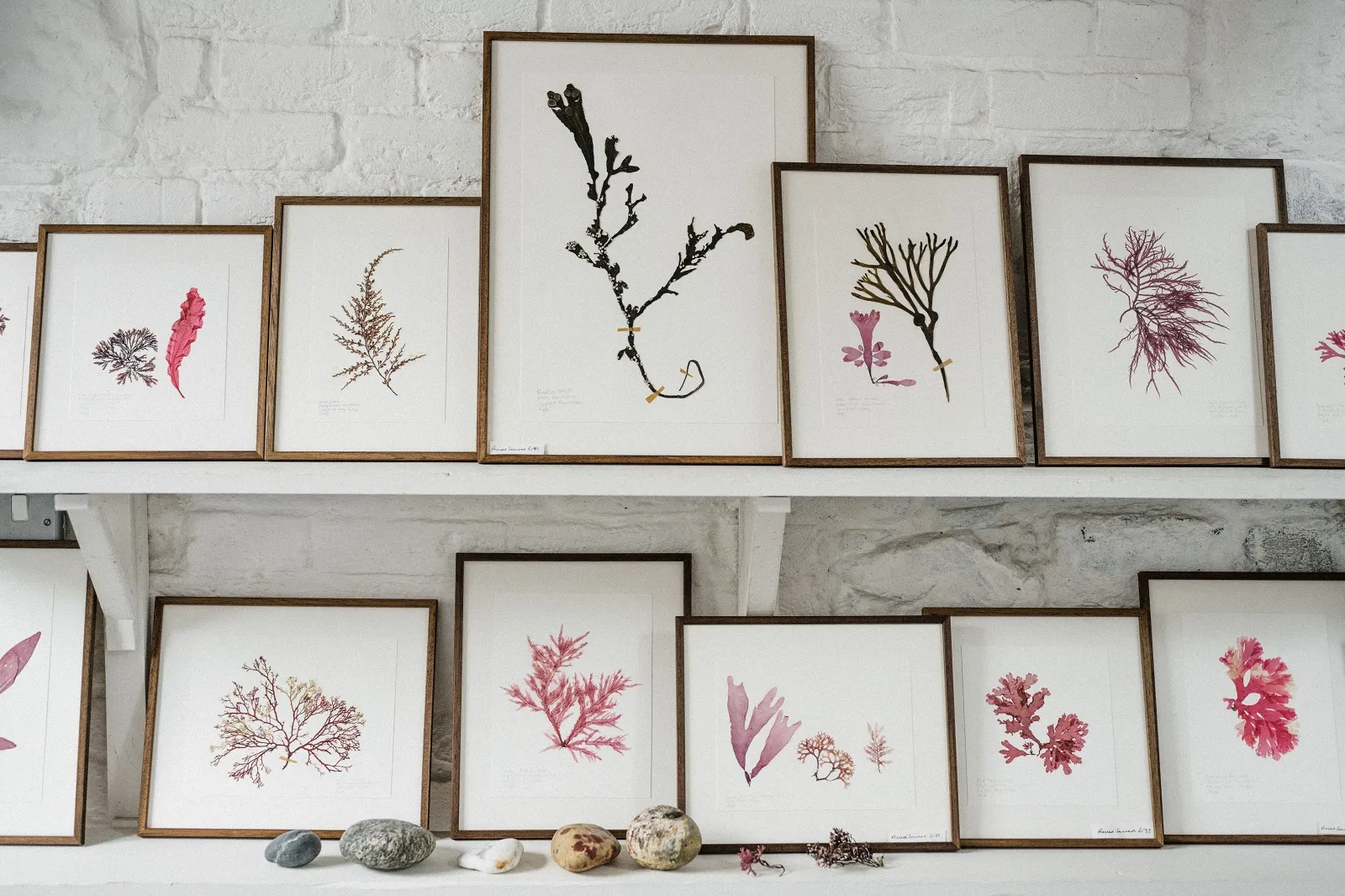
Image credit: Matt Austin
“The fine beautiful samples that we choose to press need water to support their form, so you only notice them if you’re in the water. I’m fascinated by the beauty and variety,” says Julia. “And learning about what a superfood they are, how each species has its own combination of vitamins, minerals and proteins.”
For Julia, revealing the beauty of this “garden under the sea” has an important role to play in restoring and protecting it. “For me, it’s partly if you know there’s a beautiful world under there you can foster that respect and love we need to maintain it and look after it.”
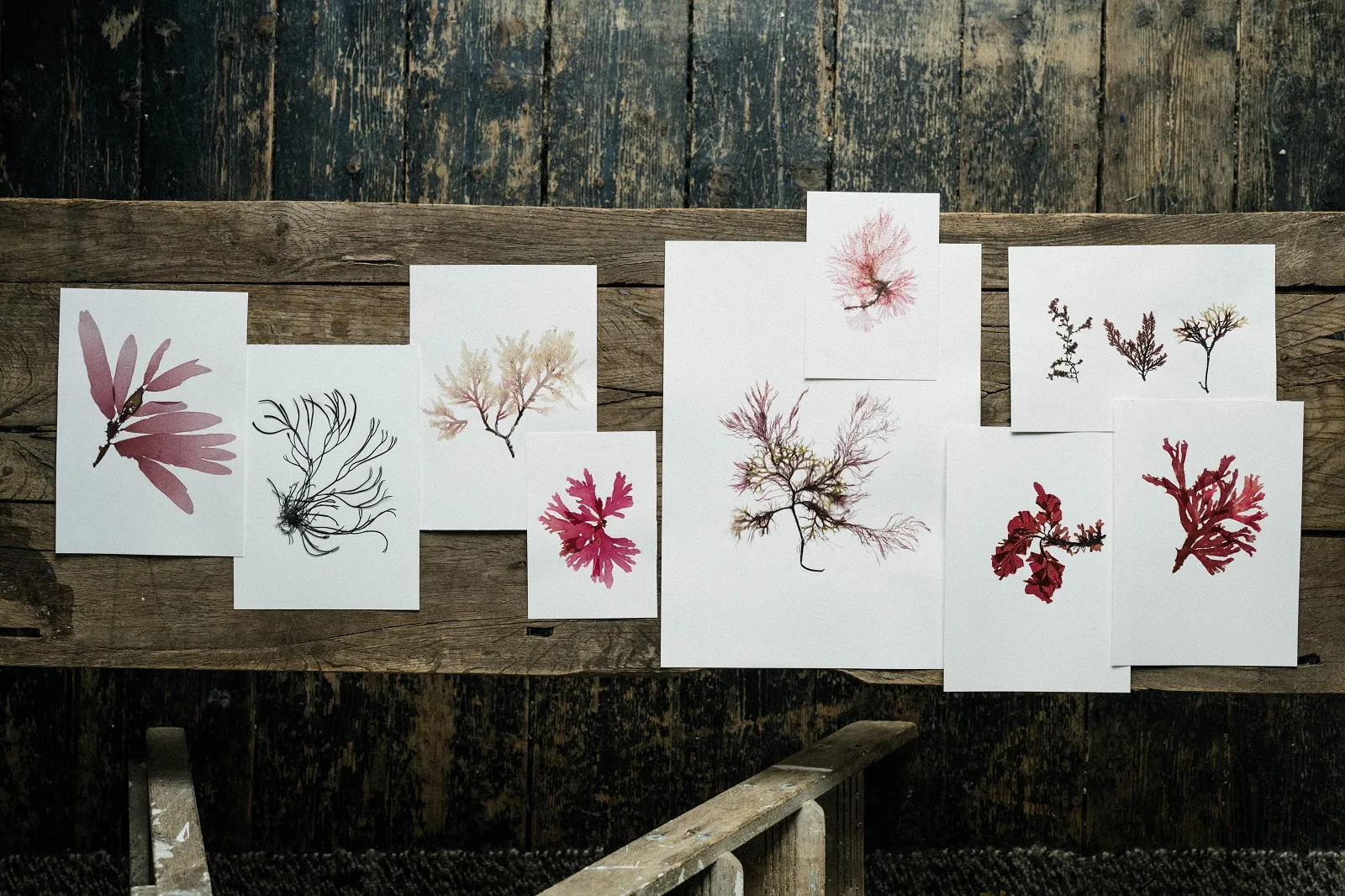
Image credit: Matt Austin
For Caroline Davey of Fat Hen, the wild cookery school, summer is all about the estuary and salt marshes. “This time of year is when marsh samphire is coming into season, that’s June to September. There’s also sea purslane, sea blight and sea arrowgrass, which is like coriander; these are all species that grow in estuaries and salt marshes.”
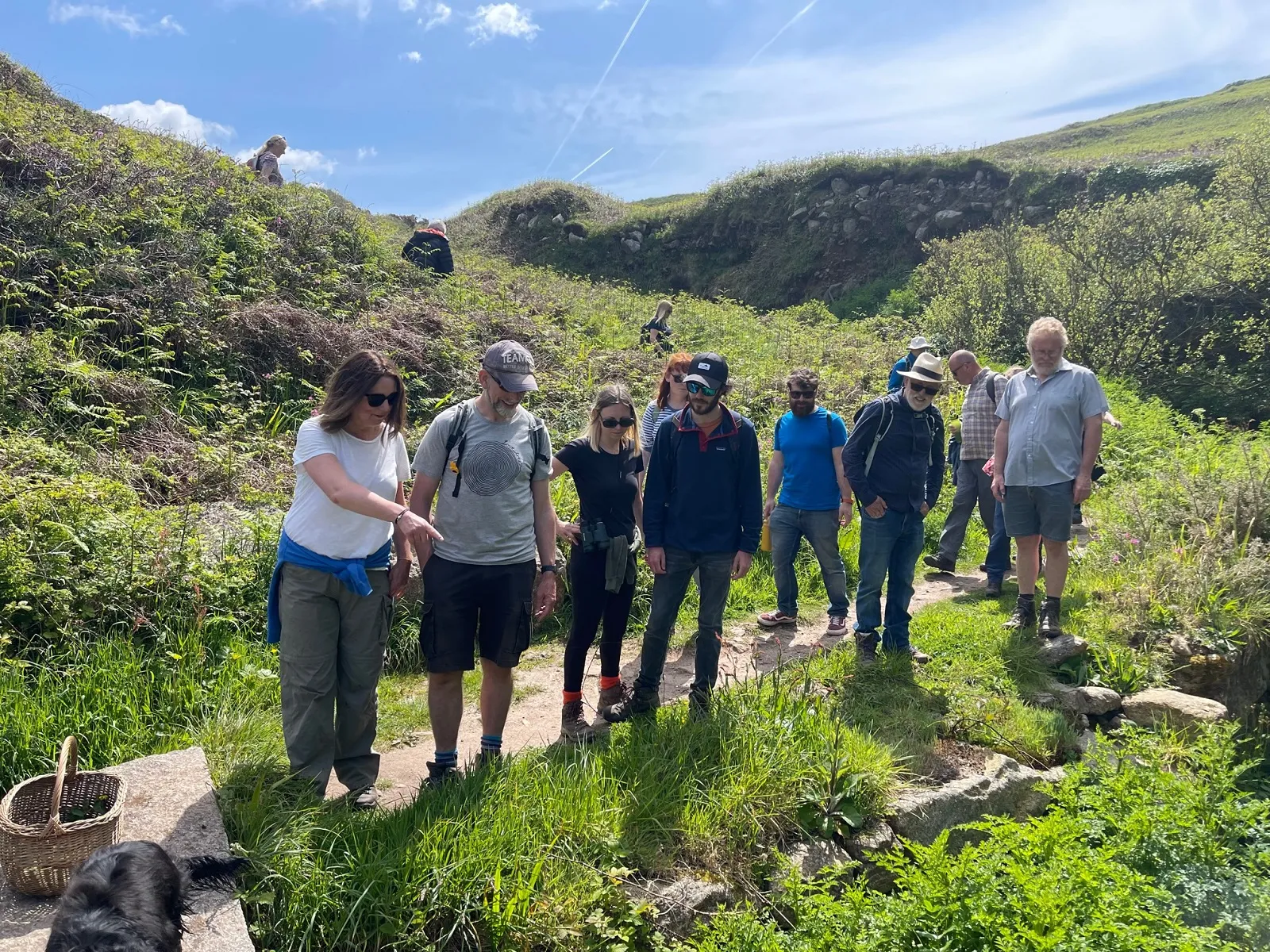
Image credit: The Fat Hen Cookery School
Caroline is running a number of coastal Fat Hen foraging courses this year, including a recent foraging walk along the coast path followed by a four-course lunch at the Gurnards Head near Zennor in west Cornwall, and a foraging walk, wild picnic and wild spa day near the Helford river on dates in June, July, September and October. All revealing hidden tastes and produce growing wild around the coastline.
She says it’s a time of abundance across the countryside beyond the sea: the plant fat hen – the vernacular name for chenopodium album – found across the country is in season, including its coastal relative spear-leaved orache, which can be used as a spinach alternative.
Caroline says wild cabbage – which grows on clifftops around the coast – is coming into flower now with the leaves and flowers able to be picked.
“And of course there’s plenty of flowers through the summer. The flowers of rosa rugosa or Japanese rose are absolutely fantastic. It’s not strictly wild: it’s planted as a coastal hedging plant and it escapes into the wild. You can also find black mustard flowers, sea radish flowers, sea cabbage flowers and elderflowers.
“I’ve just been picking hawthorn flowers and blossom for tea; they’ve been massively in bloom recently.”
And as the flowers fade, there are seeds to be scavenged. “Sea radish at some point soon will be forming seed pods and if you catch them early enough they’re like three or four bobbles in a row with the taste of a crunchy radish, perfect for scattering on salads.”
From estuary banks to clear blue pools, reveal fascinating finds along the coast.
Find your place by the sea, a walk from door to shore
Uncover the enchanting allure of Fowey’s no-drive delights, where every corner offers a new adventure and relaxation awaits just a stone’s throw away.
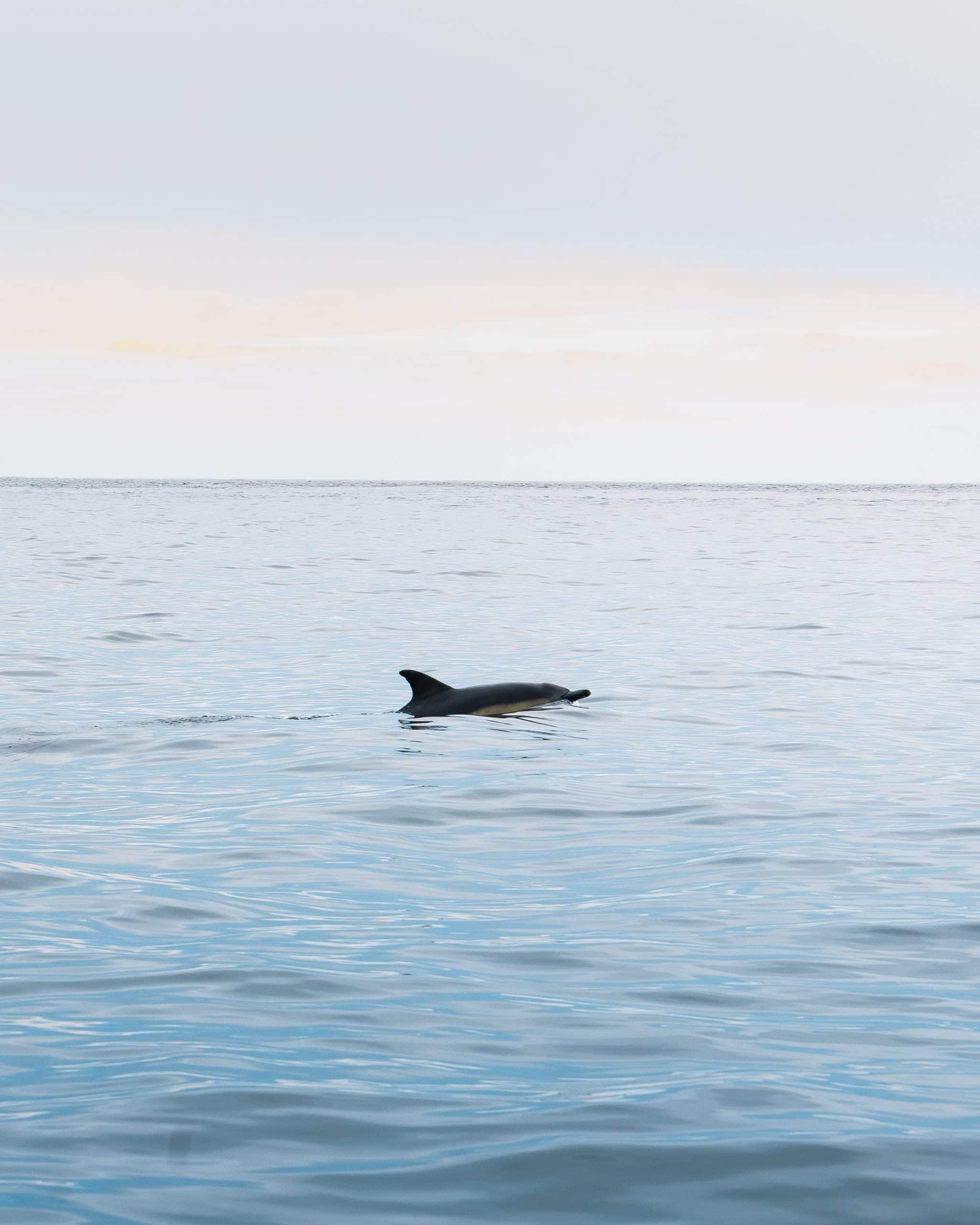
Summer is in the air and Cornwall’s coastline is teeming with birds and marine life…
Dolphins frolic in the bays, the call of seabirds echoes from the cliff ledges and seals hunt fish in the shallows, making it the perfect season for a wildlife walk.
Fancy staying in a holiday retreat with a hot tub? Check out our cottages with a hot tub for a relaxing getaway.
Check out some of our favourite places to spot some of Cornwall’s eye-catching indigenous wildlife:
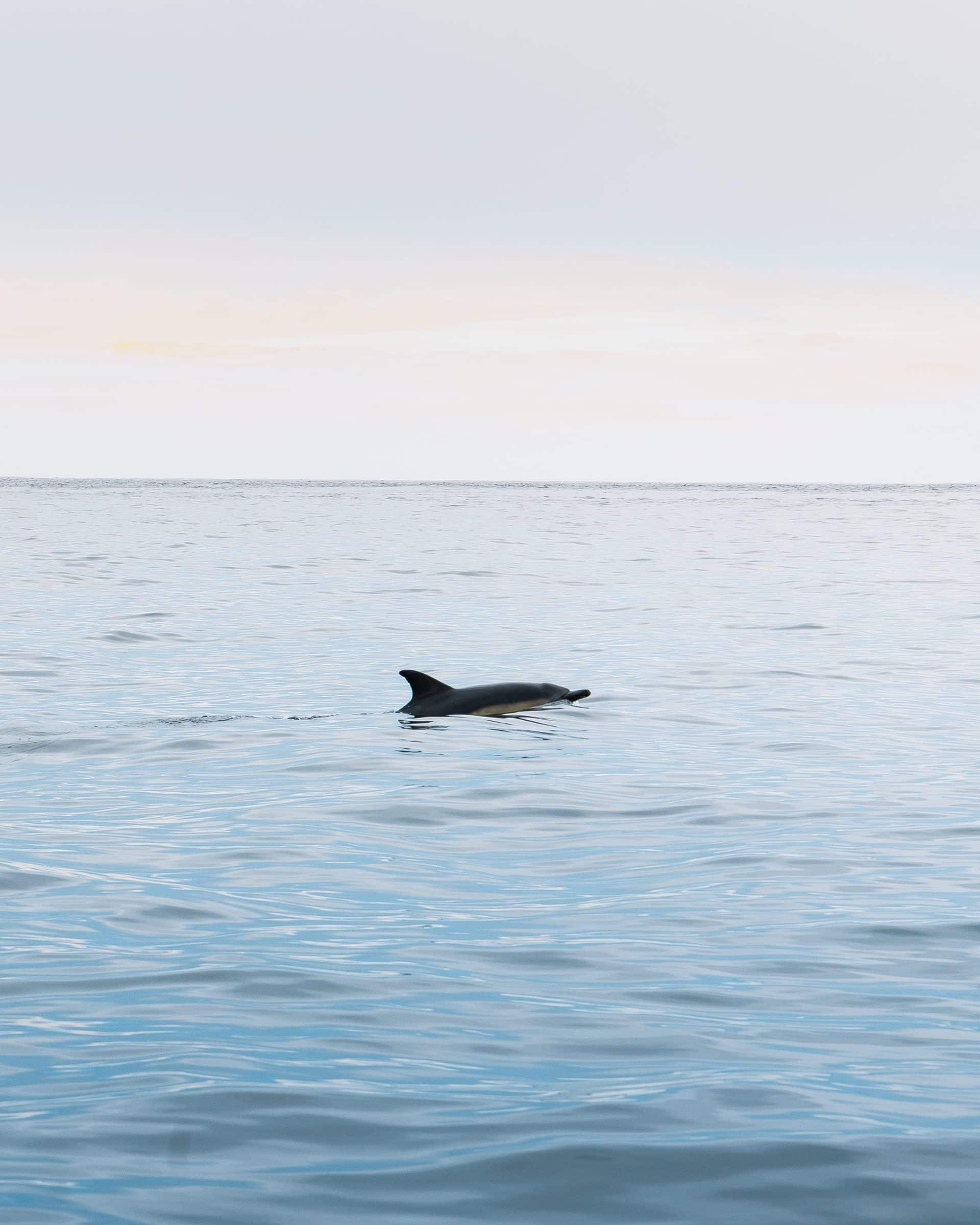
Dolphins are resident year-round in Cornwall and – despite December’s stormy weather – as soon as the sun popped it’s head out in early January, a pod of dolphins were spotted playing in the waters of Mount’s Bay. A stroll along the coastline from Marazion to Mousehole is magical in any season, and if you cross the causeway to St Michael’s Mount, the turrets of this sea-bound fortress make a fantastic vantage point to spot dolphins in the bay.
WALK: Marazion to Mousehole
VISIT: St Michael’s Mount
STAY: Mousehole Accommodation
Head to Godrevy’s National Trust car park and strike out to the headland that nudges the iconic lighthouse immortalised by Virginia Woolf. On the far side of the promontory at Navax Point, you can peer down to an inaccessible cove to witness a colony of seals basking on the sand and fishing in the shallows. Or, take a spin along Newquay’s shoreline, stopping to watch the fishing boats puttering in and out of the harbour, often trailed by the whiskered noses of inquisitive seals hoping to share their catch.
WALK: Newquay Bay
VISIT: Blue Reef Aquarium
STAY: Fistral beach Accommodation
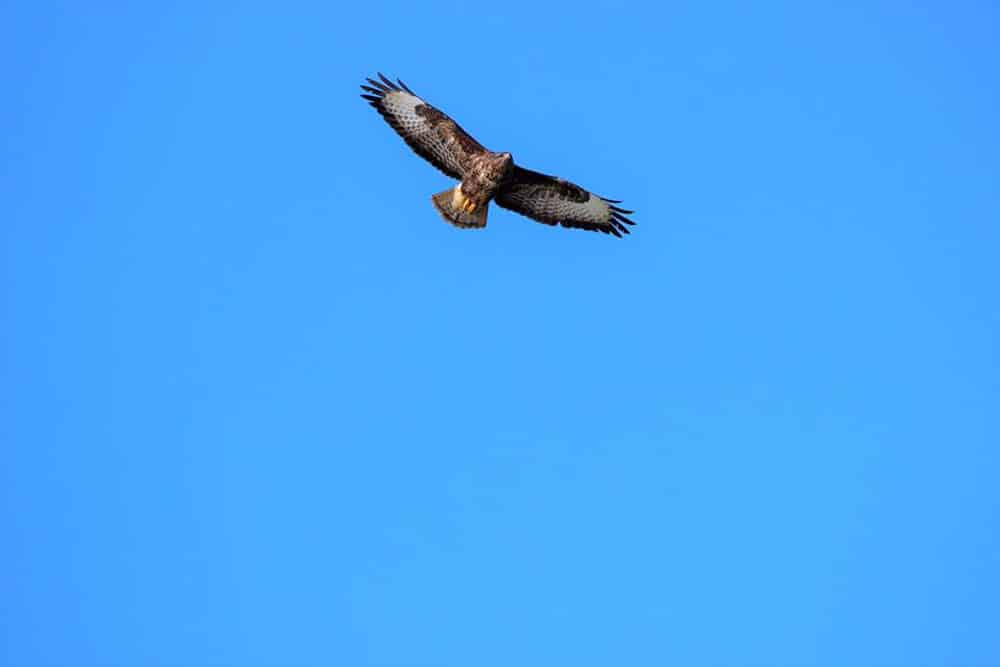
Photo Credit Adrian Napper.
Park at the National Trust car park by Bedruthan Steps and take the walk from here to Porthcothan, listening out for the call of seabirds from the rugged cliff ledges. Bring a pair of binoculars and you might be able to spot skylarks, kestrels, buzzards and even the rare Cornish chough.
WALK: Bedruthan Steps to Porthcothan
VISIT: Carnewas Tearooms
STAY: Porthcothan Accommodation
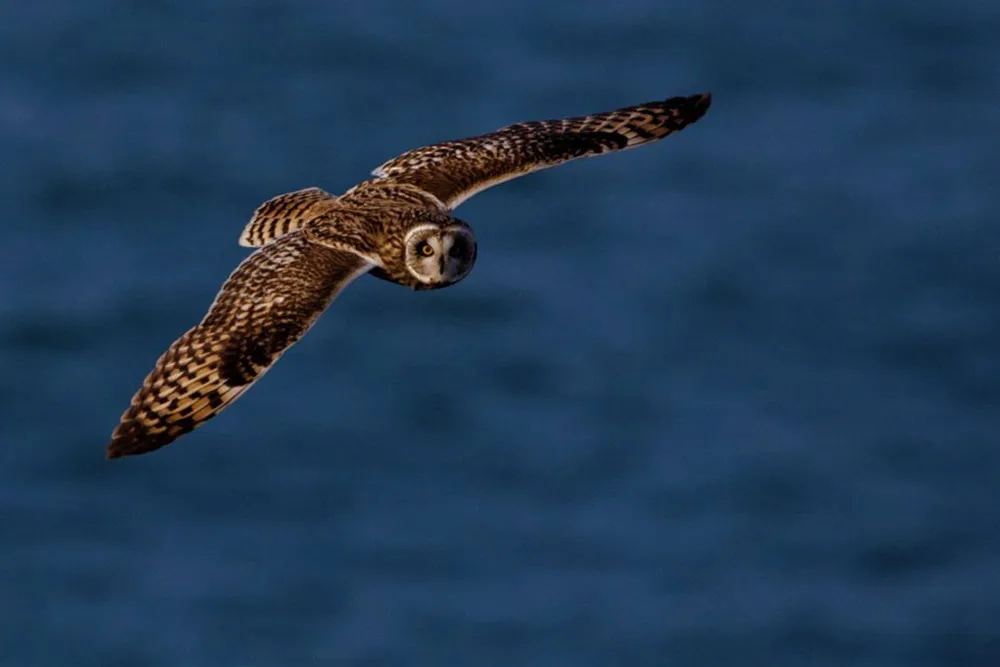
Photo credit @djedge77 on Instagram.
First light is the perfect time for a peaceful stroll along Newquay’s wave-lashed Pentire Headland, from where you can see for miles along the coastline in both directions. As well as taking in the scenery, keep an eye out for the short-eared owl, often seen flying low on the hunt for small birds. Finish your walk with coffee at the stylish Lewinnick Lodge, where you might also be lucky enough to spot passing dolphins from your window table.
Want to stay in Newquay? Have a look at our luxury holiday properties in Newquay.
WALK: Pentire Headland, Newquay
VISIT: Lewnnick Lodge
STAY: Fistral Beach Accommodation
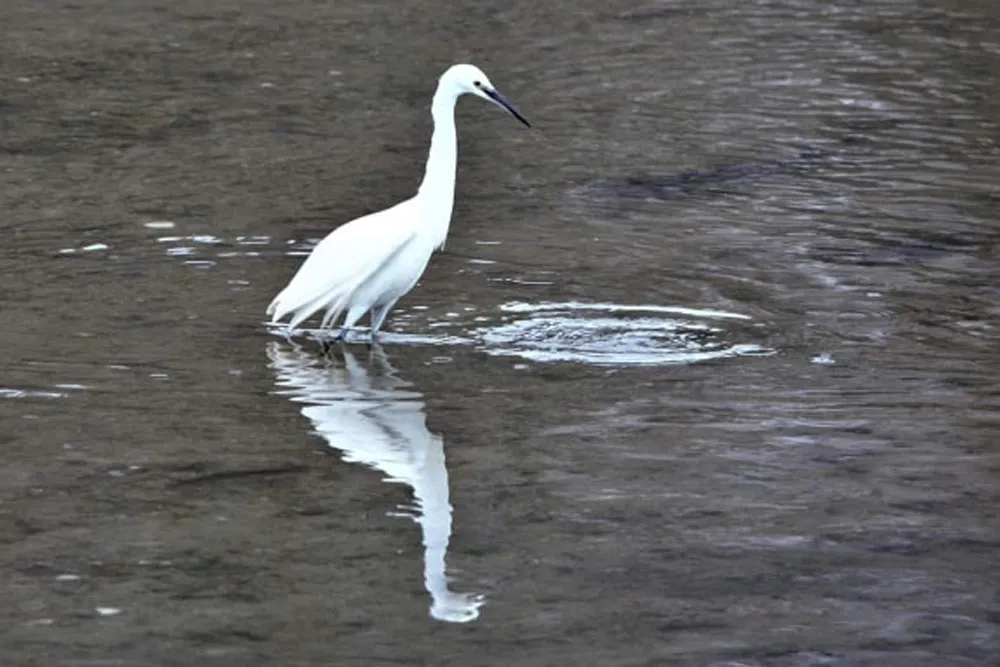
Photo Credit Adrian Napper.
A walk along the banks of The Gannel often provides welcome shelter from the coastal breeze on an early spring day. So it’s little wonder that up to 5,000 species of birds have been spotted here, sheltering from the harsh northern winters. Keep an eye out for the distinctive yellow feet of the Little Egret, a white heron with a long black beak that it uses to forage for worms as it wades along the mudflats at low tide.
WALK: The Gannel
VISIT: Fistral Beach, dubbed the UK’s surfing capital
STAY: Holywell Bay Accommodation
To find out more about Cornwall’s wildlife, bag a seat for the award-winning film, Wild Cornwall – Out on the Edge, showing in cinemas across Cornwall throughout February and March. Shot by wildlife enthusiast, Ian McCarthy, the film features Cornwall’s wildlife from peregrine falcons, dolphins and seals, to bats and otters.
Discover what to do when encountering a seal pup in Cornwall, ensuring their safety and your enjoyment of this special coastal wildlife moment.
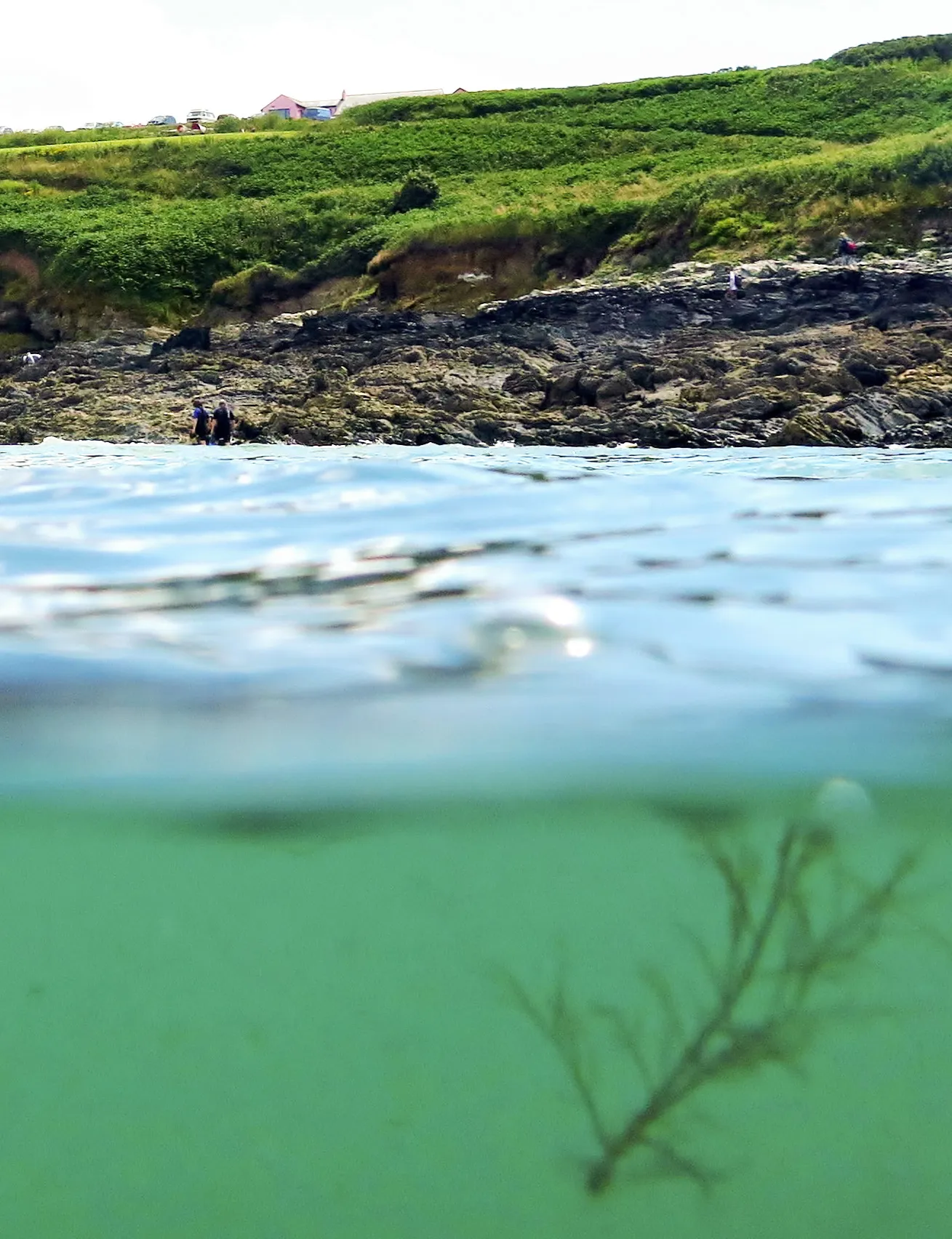
Among the slippery rocks and swaying seaweed of Cornwall’s many coves and rock pools lie bright colour shows and surprising shimmers of pinks, yellows and greens. From cunningly disguised crabs and solar-powered slugs, to UV discoveries and night swims in a sparkling sea, we talked to rock-pooling expert Heather Buttivant about what to look out for…
The coastal waters of Cornwall are micro worlds of amazing creatures and plants in a collage of colour that isn’t always obvious, but can be a dazzling discovery for any intrepid beach explorer.
Want to stay in a luxury holiday house with a view of the sea? Check out our cottages with sea views.

Image: Crantock, Cornwall by Hydro Motion Media
“I grew up on the north coast of Cornwall and spent a lot of my childhood on beaches,” says Heather. “I was always completely fascinated by the weirdness of that world, and by the colours. Collecting shells was a massive thing as a kid, and I’ve returned to it as an adult. It’s become my world again.”
While she isn’t a formally trained marine biologist, through courses and working alongside experts, Heather has developed an expert eye and brought this to her enthusiasm for rock pools. She posts about her discoveries at the Cornish Rock Pools website, and has written two books Rock Pool: Extraordinary Encounters Between the Tides, and Beach Explorer: 50 Things to See and Discover.
“I wanted to share my excitement about all of this marine life with people who aren’t scientists,” she explains. “It seemed to be a gap; there was very little around that was designed to tell people about our fascinating marine life – especially the marine life we have around Cornwall.”
Check out our other locations and other retreats across North Cornwall.
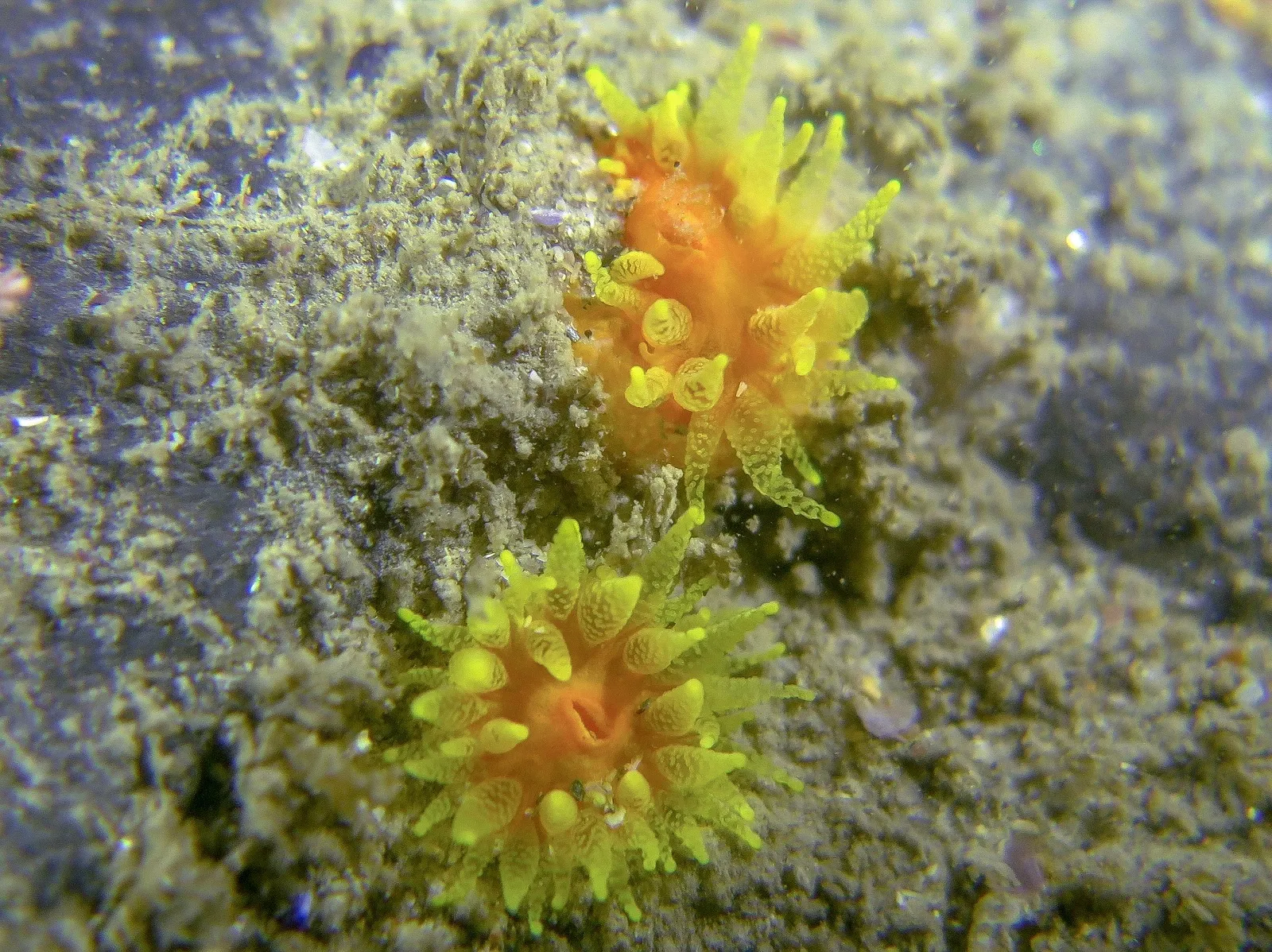
Image: Scarlet and gold star coral (Balanonphyllia) by Hydro Motion Media
Striking colours can be uncovered just below the surface, from brightly coloured anemones – like “the wonderful strawberry anemone” – to yellow and orange cup corals, “the jewels of the rock pools”.
“We also have a massive variety of seaweeds that come in a huge range of colours, from reds to browns to greens,” she continues. “My favourite to show children is rainbow wrack; in the water it’s the most wonderful iridescent turquoise colour. But out of the water it just looks a dull green-brown.”
If you’re exploring deeper rockpools or have a mask and snorkel to hand, many species of fish can be found close to the shore. The corkwing wrasse builds its seaweed nest just offshore, while the young of the larger ballan wrasse – also sometimes seen in rock pools – are a bright emerald green.
Another fish you might catch sight of in shallow waters, pouting or bib, is a deep coppery colour with three or four vertical bands that shimmer in the light shining down through the water. They like mixed rock and sand habitats, as well as ship wrecks.
Discover more of Cornwall with our favourite places to watch the ocean and go sea spotting.
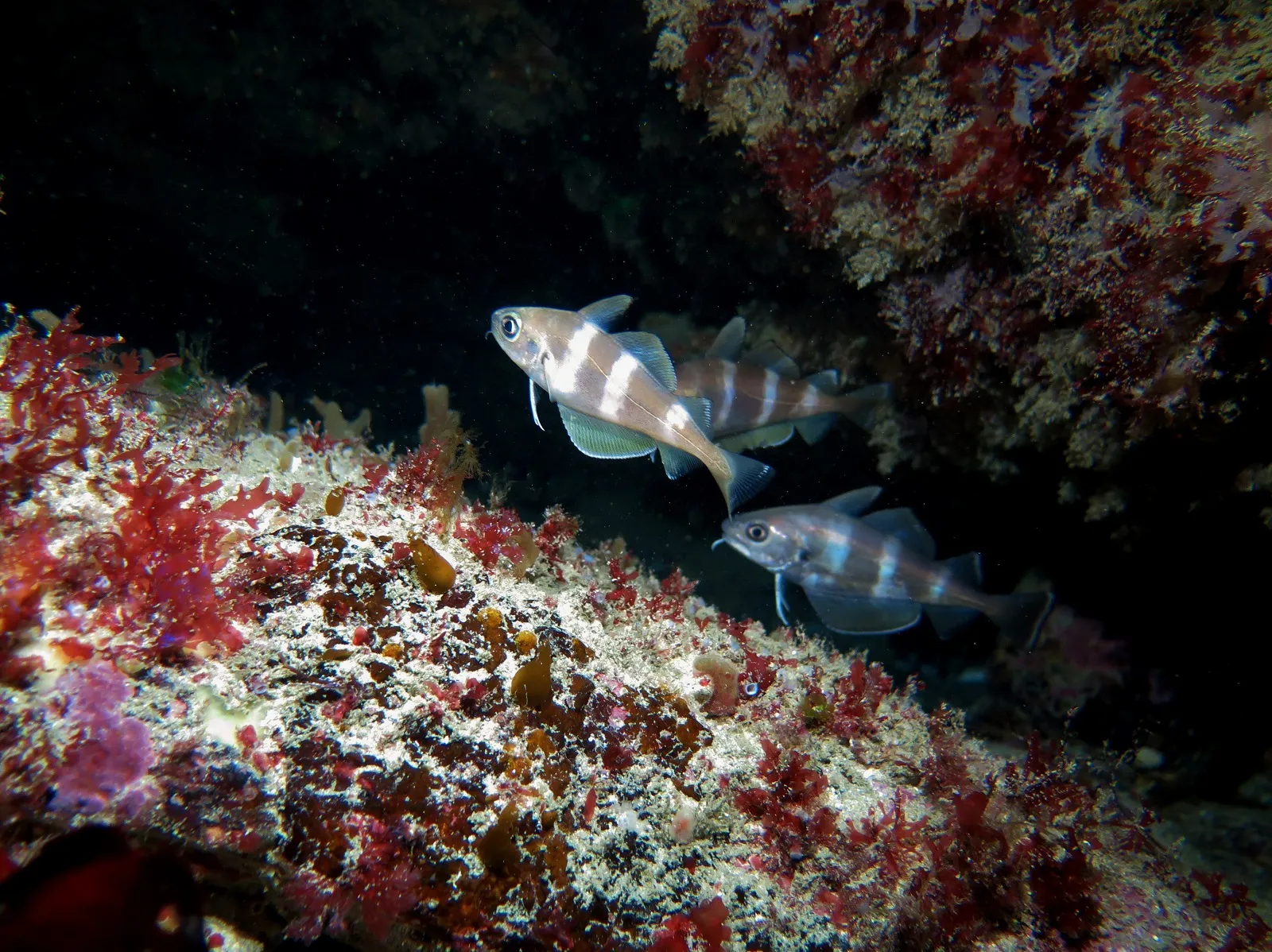
Image: Pouting (Trisopterus luscus) by Hydro Motion Media
They might not sound like the most appealing discovery, but unlike their garden-dwelling namesake, sea slugs actually take on an infinite variety of colours. They’re not easy to find, but if you’re lucky to discover one you may be surprised at these “tiny beacons of yellow, green, orange, purple or red” – “It can become an obsessive hunt,” says Heather.
Like their fellow rockpool creatures, sea slugs are often coloured to match the seaweed, rocks or encrusting animals in their habitats – and will change colour as it goes, or after a meal. “The great grey sea slug feeds on anemones; after it’s eaten, it’ll turn the red or pink of the anemone it’s just eaten – and also retain some of its stinging cells, keeping them as a defence on its back,” Heather explains.
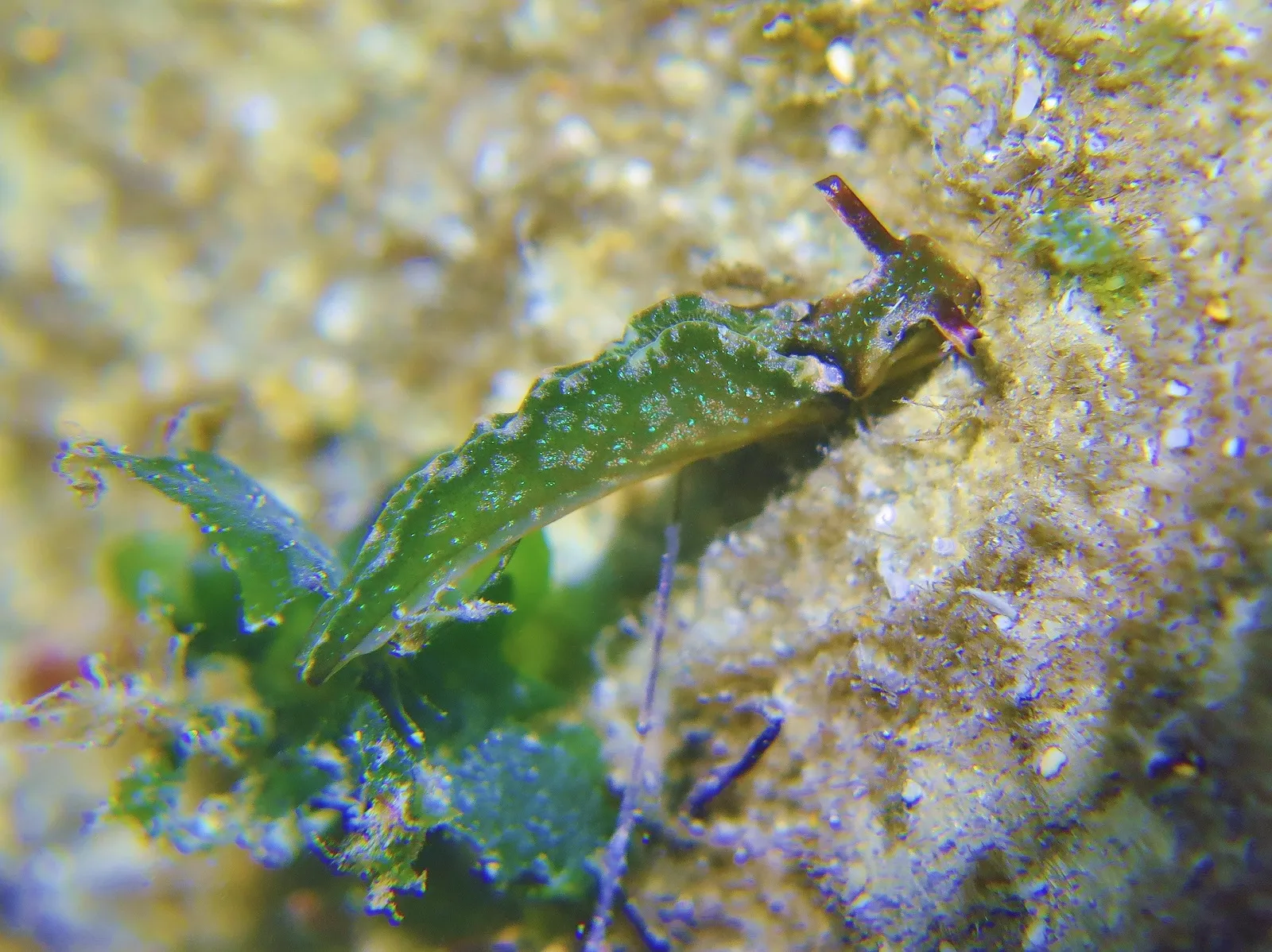
Image: Solar-powered sea slug (Elysia viridis) by Hydro Motion Media
Some species of crab also take to wearing their habitat, by attaching pieces of sea sponge to their shell and limbs or using little ‘Velcro-style’ hairs to drape themselves in seaweed. “They just look like another rock covered in seaweed until they get up and run off,” says Heather.
A lot of sea creatures are more active at night, so a rock-pooling expedition by torchlight may reveal more than on a sunny beach afternoon – with an added sense of adventure to boot.
Along Cornwall’s south coast, it’s also possible – though rare – to see the bioluminescence (also known as sea sparkle and phosphorescence) created by planktonic algal blooms, shining out from the water. Nothing beats a night swim (stay safely within your depth) under the stars above, with the sparkling sea glinting between your fingertips as you stroke through the water below. These areas of phytoplankton are naturally occurring, generally in mid-late summer or early autumn, and are not harmful to the coastal environment.
A far more common phenomenon revealed by an ultra violet (UV) light (if you happen to have one, or join an organised tour) is the fluorescence that specific marine life creates by re-emitting sunlight at a different wavelength. The snakelocks anemone shines neon green under UV light and some species of crab appear blue.
“Just take the time to go slowly, look closely at pretty much any rock pool and you’ll start to notice the animals there,” Heather recommends. “But bear in mind that these things are quite well hidden!”
These creatures are best observed in their natural environment, so resist the temptation to catch them in a bucket if you can – or at least make sure your bucket is full of seawater, and that you put them back in the same place you found them before you leave. Animals can also be easily injured, so avoid using nets if possible.
“Prawns and blennies will swim over to have a look if a camera is in the water, and it’s not that unusual to see two hermit crabs having a fight,” notes Heather. “These things are absolutely fascinating to watch.”
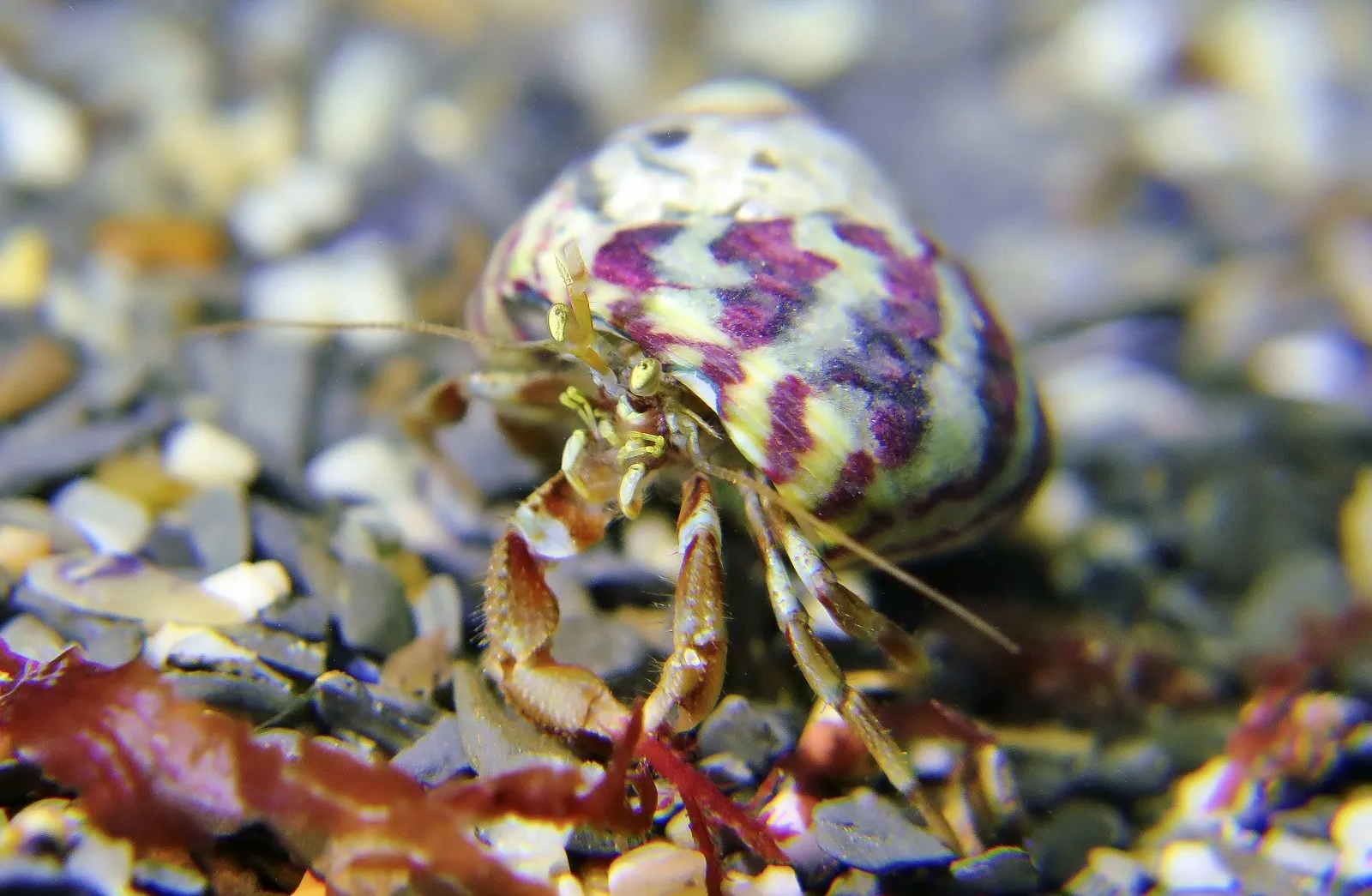
Image: Hermit crab (Pagurus bernhardus) by Hydro Motion Media
One of the best ways to make discoveries is to join a tour. The Cornwall Wildlife Trust organises beach events throughout the year, and there are also local conservation groups running rock pool activities across Cornwall.
Find tips on Heather’s website, and pick up a copy of her books in bookshops around the county and online.
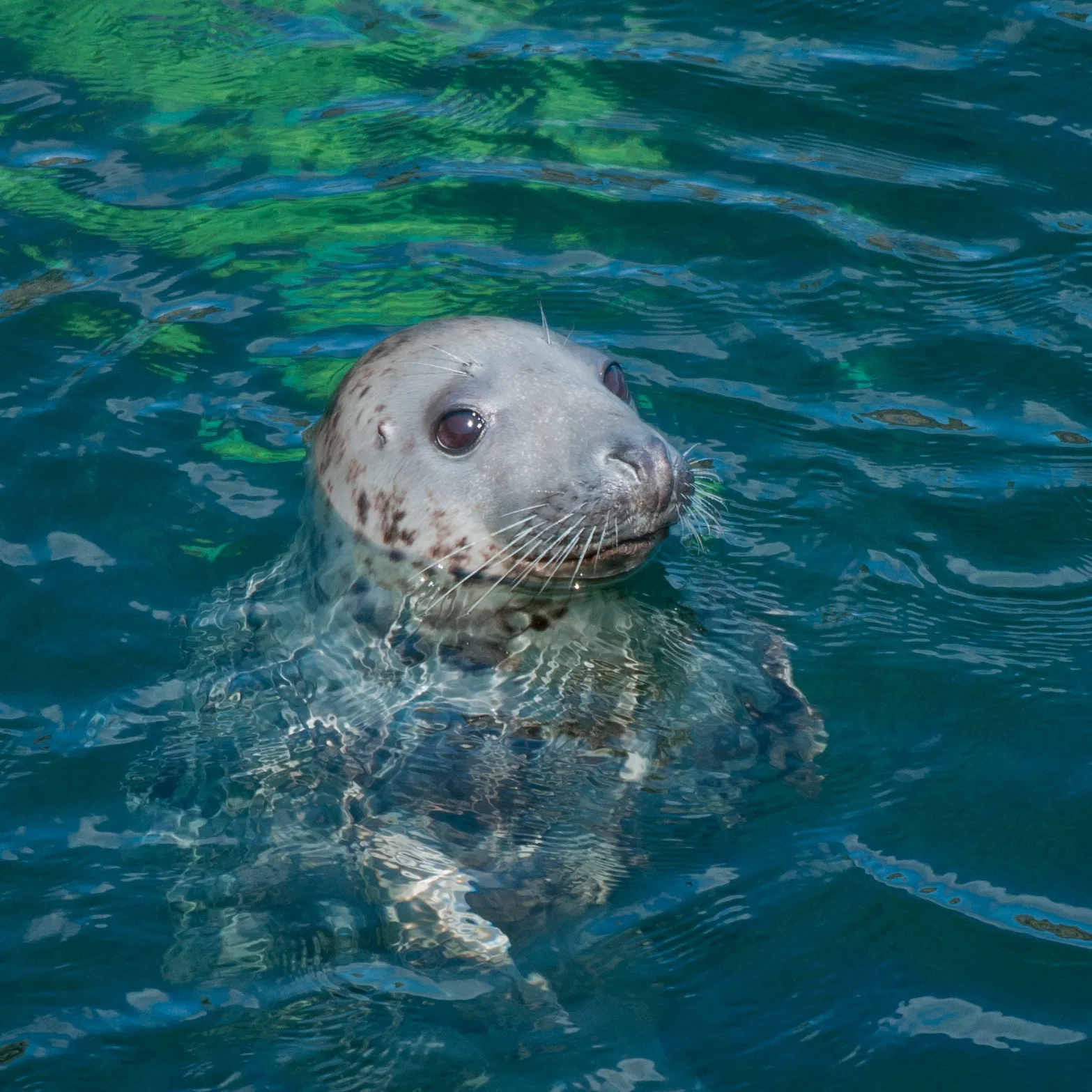
Cornwall is teeming with grey seals, but in winter you might come across seal pups stranded on the coastline in difficulty.
Visiting with a large group? Discover our large holiday homes perfect for big families or friend groups.
On your rambles along the South West Coast Path, it’s always a delight to spot the whiskered nose of a grey seal break the surface. You might even be lucky enough to have a close encounter with one of these majestic mammals when you’re swimming, paddleboarding, kayaking or surfing. Or spot one in the wake of a fishing boat chugging into a harbour with fresh catch.
Seals are one of the most frequently sighted marine mammals in Cornwall. However, as winter approaches, large numbers of seal pups are found stranded on Cornwall’s beaches or hauled out on rocks, due to malnourishment, injury, or being washed up in stormy conditions. And while it might be your natural instinct to herd them back into the sea in the hope of re-uniting them with their families, many of them need care and attention before being able to survive back in the wild Atlantic Ocean.
For over 60 years the Cornish Seal Sanctuary in Gweek has been a rescue facility for seal pups and injured seals. Much more than a visitor attraction where you’re guaranteed a close encounter with seals, here you can witness them dipping and diving their way to recovery, learn all about the species, and see lots of different marine wildlife including sea lions, otters, penguins, crabs and starfish. As well as seeing the seals in all stages of recovery, you can watch a practical demonstration about handling and rescuing seal pups – which is a starting point if you do come across one stranded on your beach wanderings.
The Cornish Seal Sanctuary rescues more than 75 pups in need every winter. Adopting decades of experience, a team of experts administer care, lifesaving medication and even vital surgery, to enable the seals to recover and be released back into the wild when they are ready to fend for themselves once again. The sanctuary also provides a permanent home to any seals with ongoing medical issues that prevent them surviving in the ocean.
A day out at the Seal Sanctuary is an eye opening, entertaining and educational day out for the whole family. Here you trace the steps of seals in recovery – from the most recently rescued pups undergoing care in the seal hospital, to those in their final stages of rehabilitation in the convalescence pool. You can also come nose-to-nose with seals, sea lions and penguins in the underwater viewing areas.
Discover our Porthleven holiday properties. Just 20 minutes away from the Cornish Seal Sanctuary.
While you can support the charity by visiting the sanctuary and donating to support the seal pups, you can also help by taking the right steps if you do come across a stranded seal pup on the beach. Firstly, do not approach the seal – and make sure you keep dogs and children away from it. Seals are wild animals and will defend themselves aggressively if they feel threatened, so keep your distance and observe the seal pup to assess whether it is in need. Seals regularly haul out on our coasts – it is part of their normal behaviour and therefore finding a seal on the beach does not mean there is necessarily a problem.
Discover five places to spot wildlife along the Cornish coast, where nature thrives amidst stunning landscapes and coastal beauty.
Abandonment or separation
If you see a seal with a white, long-haired coat in the autumn/winter, then it is probably still suckling from its mother. Check the sea regularly for any sign of an adult seal.
Malnourishment
Signs of malnutrition include visible ribs, hips and neck and baggy, wrinkled skin.
Bad health
Signs of ill health can include coughing and sneezing, noisy and rapid breathing, or thick mucus coming from the nose, wounds or swellings.
Injury or entanglement
Seals often get tangled in fishing gear and other debris. While heavy commercial gear is obvious, monofilament nets and line are hard to see when they are caught around the neck, flippers and body.
If you do find a seal pup in distress or need, these tips from the Seal Sanctuary and the British Divers Marine Life Rescue will ensure you do all you can to facilitate its safe and effective recovery:
Keep your distance
Take a good look to ascertain if the pup is alone, unwell, malnourished or injured.
Don’t touch the pup
It is a wild animal with sharp teeth. A mother may reject her pup if it smells of people, so keep downwind and (if possible) out of sight.
Don’t chase the seal back in the sea
A white-coated pup spends most time out of water. All seals haul out onto land to rest, digest and socialise all year round.
Do something about it
Phone the Cornish Seal Sanctuary for expert advice on 01326 221 361, or British Divers Marine Life Rescue on 01825 765 546, giving an accurate location.
More information
Seal Sactuary
Put Seal Pups First
The Cornish Seal Sanctuary is part of the SEALIFE Trust charity and couldn’t do their vital work without the support of the public.
Each seal pup costs, on average, £2000 to rehabilitate, not including special cases. Due to difficulties faced following the Covid-19 pandemic, the sanctuary has launched a Put Pups First campaign to supporting the seal pups through a difficult situation, provide advice and information to the public, and help the Cornish Seal Sanctuary continue their work.
Last year it was Pedn Vounder and Kynance Cove that captured the Insta crowds and went viral on social media. So what are the most Instagrammable locations of Cornwall in 2019?
Interested in staying in our most luxurious holiday cottages? Check out our luxury coastal cottages.
The home of Doc Martin is a picture-postcard Cornish village flaunting cobbled streets, cream tea cafés and sublime sea views. We’re so used to seeing it on our TV screens that we half expect the Doc to come dashing down the winding streets to the harbour, where fishing boats putter in to deliver fresh catch to Nathan Outlaw’s restaurants. With wild Cornish cliffs that yawn in each direction, it’s little wonder that the Doc chose to live here, and less wonder that we’re so fixated by his appearance on our TV screens – who knows if it’s Doc Martin or Port Isaac that’s the real star of the show.
Find a self-catering holiday in Port Isaac.
Dubbed Britain’s equivalent of Australia’s Twelve Apostles, us mere mortals are dwarfed by the towering rock stacks rising from the sands of this craggy cove north of Newquay. Stand atop the cliffs and you can watch the waves carving the granite turrets, said to be the stepping-stones of a legendary giant. Or wait for low tide and descend the cliff steps to pad along the white sands, peering down into the rock pools and up to the peaks of these barnacle-clad skyscrapers. Don’t be content with taking in the view from the coast path with the rest of the camera-wielding visitors, plug on along the coast path to Park Head, passing ancient burial mounds and the ruins of a cliff fort, while keeping an eye out for seals and seabirds.
Find a self-catering holiday near Bedruthan.
Climb the rusty-red backs of the cliffs from Chapel Porth beach, to reach this iconic engine house that casts a shadow over the wild Atlantic waves. As you explore the coast path you’re setting foot in some of Cornwall’s richest mining history, while below the pumping surf breaks are known as the legendary ‘Badlands’. While the waves aren’t the territory of beginners, when you descend the pristine cove of Chapel Porth, you’ll discover the perfect spot for rock-pooling as the tide ebbs, and make sure you stop for a famous hedgehog ice cream in the National Trust car park.
Explore further from Chapel Porth & take a look and book our self-catering properties at Porthtowan, or talk to a member of our team on 01637 861 005.
Find a self-catering holiday in St Agnes.
Perched atop a sea-lashed promontory and swathed in Arthurian legend, Tintagel Castle has been a crowd-puller ever since tourism came to Cornwall. With its magnificent ruins and immense bronze statue of King Arthur looking out to sea, we expect the fortress to be high on our social media scrolls when it re-opens this summer, following the construction of a new footbridge. Touted as the birthplace of King Arthur, it’s impossible not to get swept away by local myths as you listen to your echo in the eerie Merlin’s Cave and step foot in the remains of a majestic fortress and a prosperous Dark Age settlement.
Find a self-catering holiday near Tintagel.
Cornwall’s art-deco lido has graced the screens of our social media feeds ever since it was renovated after storm damage in 2014. One of the world’s most scenic lidos, its eye-catching design and turquoise waters are hemmed by Mounts Bay. Re-opening again this summer after the development of a geo-thermal project, an area of the pool will be heated to a steaming 35C later in the year – so it’ll no longer be the territory of just hardy cold-water swimmers. In fact, you don’t even have to take a dip to enjoy the lido, simply bask on the terrace or take a seat in the year-round café and soak up the views.
Find a self-catering holiday near Jubilee Pool.
Find out about Sennen, near to Penzance, in our blog all about the area.
Having scored a starring role in the BBC’s recent Poldark hit, the breath-taking beauty of Holywell Bay needs little introduction. As soon as you clap eyes on the giant sand dunes and the twin peaks of Gull rock, you can imagine Ross Poldark galloping along the shoreline, searching for Demelza wistfully picking sea pinks on the cliff tops. Despite is fame, Holywell still keeps the crowds at bay, and makes the perfect beach for hitting the surf, collecting shells and exploring the sea caves in search of the ‘holy well’. You can also follow the coast path to Kelsey Head to spot seals and seabirds.
Find a self-catering holiday in Holywell Bay.
In the 19th century the town ‘huer’ would stand in this little stone hut on Towan Headland, crying, “Heva, Heva”, to alert the fishermen when shoals of pilchards were spotted in Newquay Bay. Having been restored in recent years to ensure Newquay’s history and heritage is not forgotten, this little whitewashed hut is a great spot to step back in time, gawp at the panoramic coastal views and see if you can spot shoals of dolphins of mackerel coming into the bay.
Find a self-catering holiday near the Huer’s Hut.